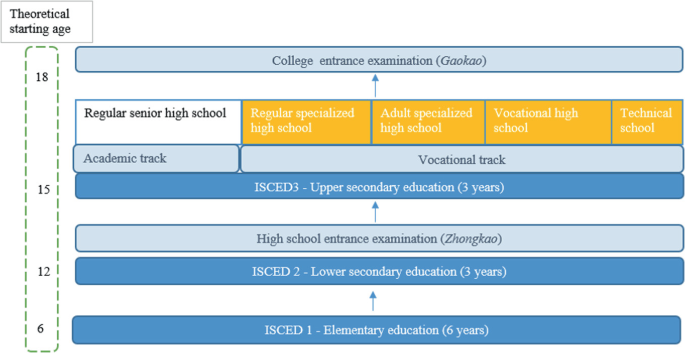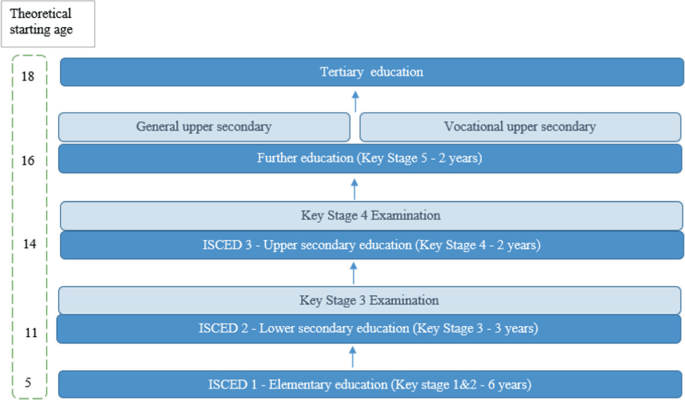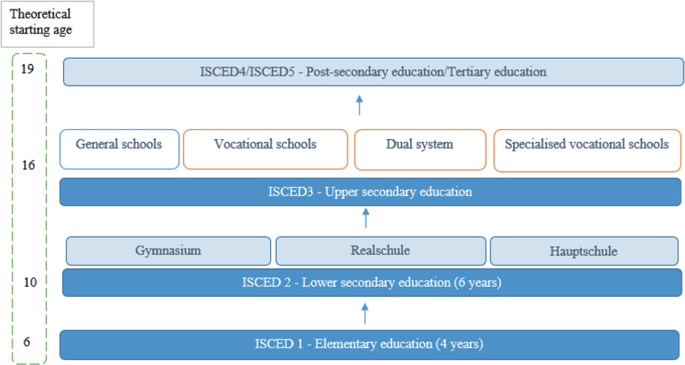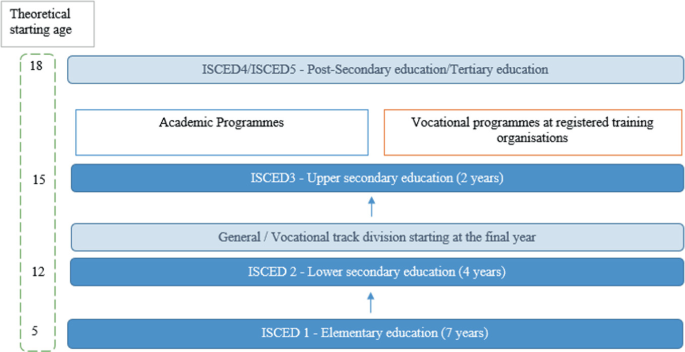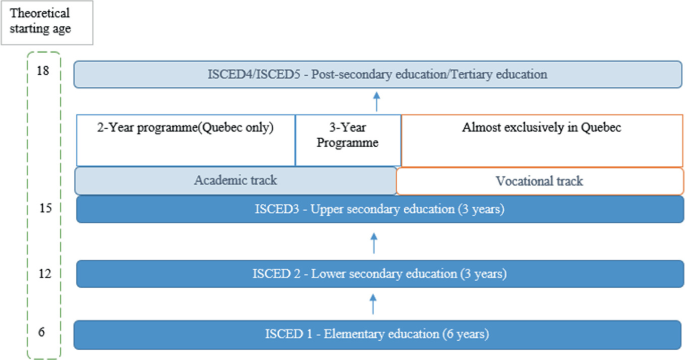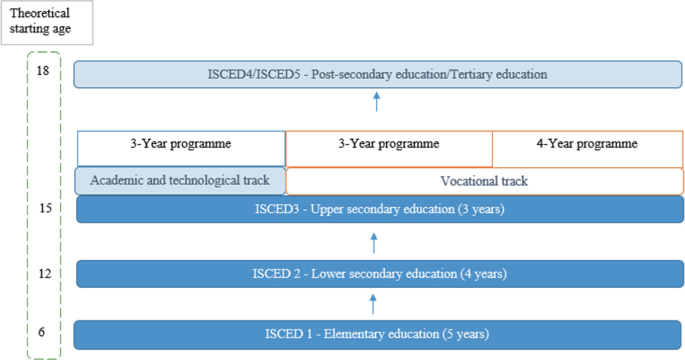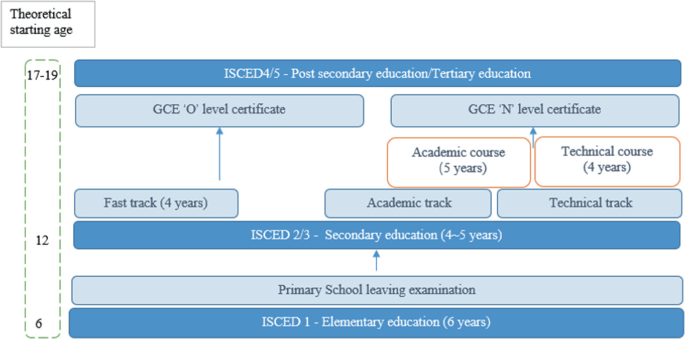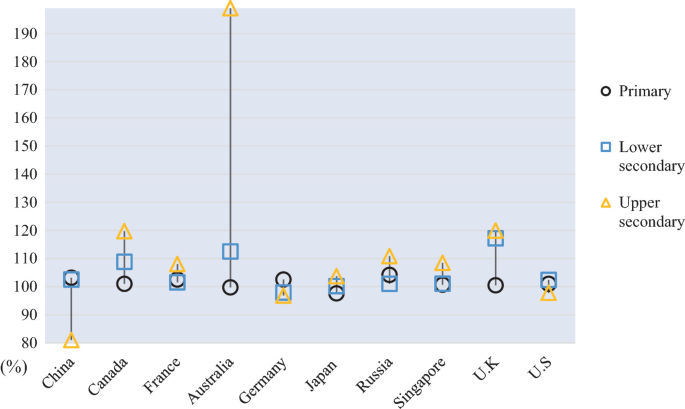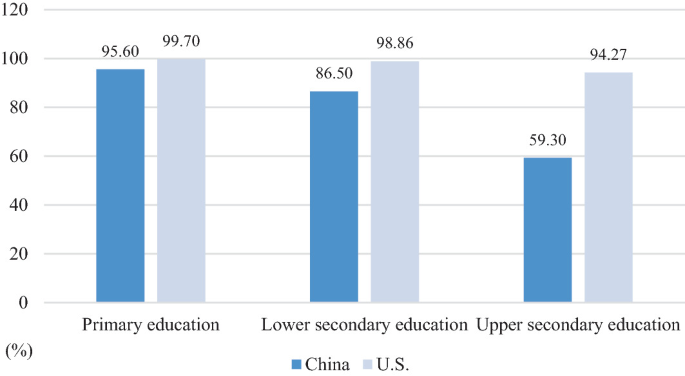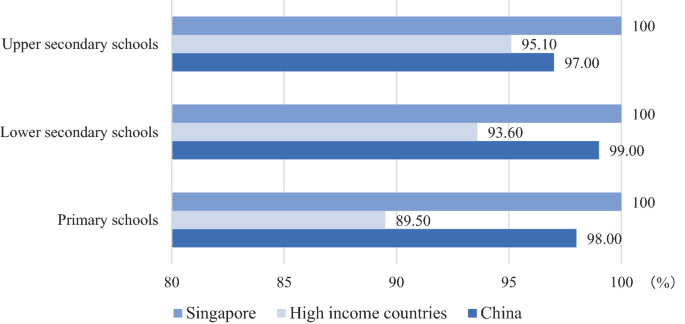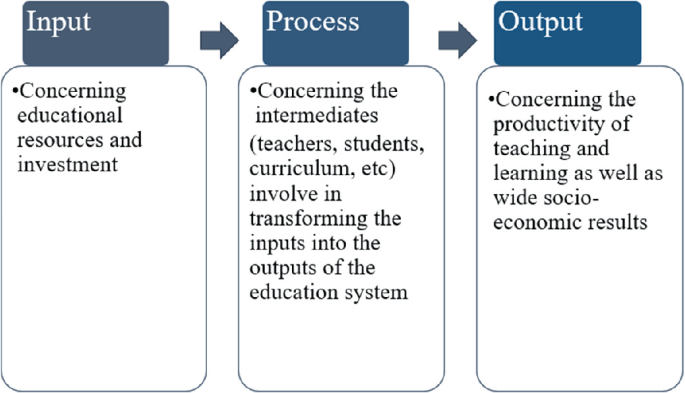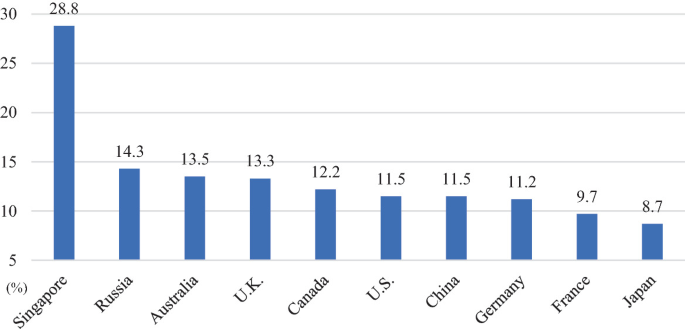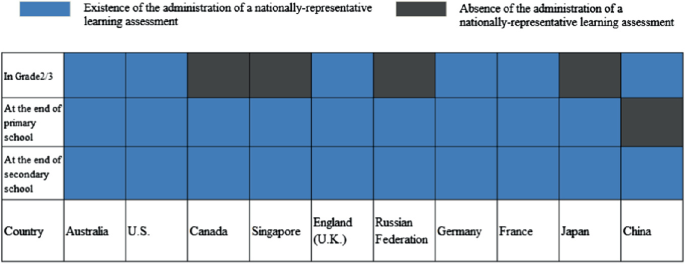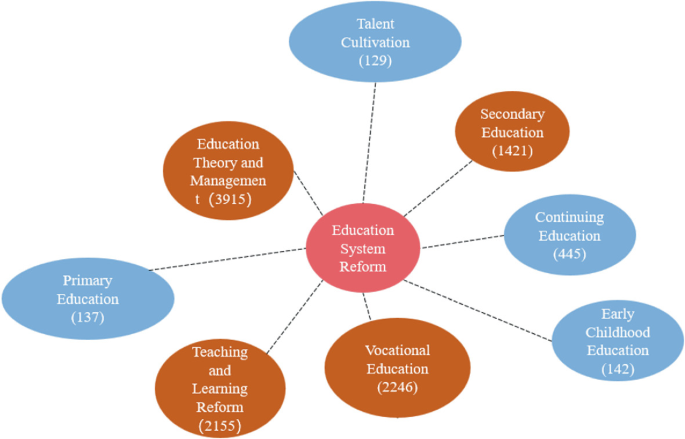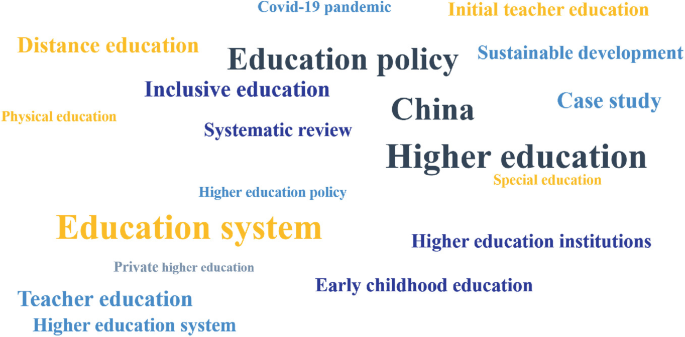Abstract
This chapter combines the quantitative data with the rich qualitative evidence and triangulates the diverse evidence to systematically unearth themes and provide an in-depth review of China’s dynamic education system. This chapter not only presents a benchmark study showing how China’s education systems perform vis-a-vis other national education systems, but also probes into the policies and practices to reveal the contextual factors contributing to the unique patterns of China’s education system.
You have full access to this open access chapter, Download chapter PDF
Similar content being viewed by others
Keywords
1 Introduction
From a global perspective, this chapter examines education systems at a national level. The concept of education systems borrows the idea of “system” from a broad definition in social science, which refers to a group of interacting or interrelated elements that act according to a set of rules to form a unified whole (Backlund, 2000). In the sphere of education, the idea of education systems typically encompasses all the elements involved in education, such as funding, facilities, staffing, curriculum, pedagogy, regulations, and policies. These elements are interrelated and organized strategically to achieve overarching educational goals. In other words, using the term “education system” aims to deconstruct the complex and multifaceted nature of education. By doing so, this chapter is able to present an overall and comparative view of the education systems in selected countries.
Based on the acknowledgment that students’ learning pathways vary among countries and regions, this chapter begins with a brief introduction of the education systems in selected countries, including Australia, Canada, China, France, Germany, Japan, Russia, Singapore, the United Kingdom (U.K.) and the United States (U.S.). The learning pathways serve as the foundation of the education systems, which determine when students start their education, what academic tracks students can choose, and how students can move vertically or horizontally to achieve their education goals. A well-designed education system provides flexible learning pathways for its learners and avoid potential social segregation (OECD, 2020).
This chapter reviews the learning pathways of education systems at the basic education level by referring to the International Standard Classification of Education (ISCED). ISCED, developed by the United Nations Educational, Scientific and Cultural Organization (UNESCO), which provides a common framework to benchmark education systems across nations (UNESCO Institute for Statistics [UIS], 2012). This chapter adopts the ISCED 2011 classification to present the learning pathways in each nation. The scope of this chapter covers only the basic education level which includes elementary education (ISCED 1), lower secondary education and upper secondary education (see Table 1). While a snapshot of the learning pathway is provided, the distinctive features embedded in these education systems are also highlighted.
1.1 China
The People’s Republic of China (hereafter “China”) has the world’s largest population of school-aged children. Its education system accommodates over 291 million students with more than 18 million teachers serving in 520,000 schools (excluding private education) (Ministry of Education [MOE], 2022). In 1986, the Chinese government regulated nine-year compulsory education in its legal framework, with the aim to provide elementary education and lower secondary education to every child in the country.
After completing nine-year compulsory education, students can choose from two distinctive learning tracks provided. One is the academic track and the other is the vocational track. On the vocational track, there are four major types of schooling available, including regular specialized high schools, adult specialized high schools, vocational high schools, and technical schools. One of the major distinctions among them is the difference in the governance bodies and the institutes issuing the certificates. Among the four programs, regular specialized high schools tend to be the mainstream one, which attracts most vocational students. However, compared with the academic track, the vocational track is overall less attractive to Chinese students and their parents (Fig. 1).
1.2 The U.K. (England Only)
The education system in the United Kingdom (U.K.) is a devolved matter with each of the jurisdictions having separate systems overseen by separate governments. The U.K. government is responsible for the education system in England, whereas education systems in Scotland, Wales and Northern Ireland are governed by their respective governments. This section only discusses the education system in England.
England also has a tradition of independent schools and home education. In England, the learning tracks in the state-funded education system are categorized into “key stages” based upon age. It begins with Early Years Foundation Stage (aged 3 to 4). Elementary education (aged 5 to 10) is subdivided into Key Stage 1 (aged 5 to 6) and Key Stage 2 (Juniors, aged 7 to 10). Secondary education (aged 11 to 15) is further split up into Key Stage 3 (aged 11 to 13) and Key Stage 4 (aged 14 to 15). Above Key Stage 4 is the post-16 education (ages 16 to 17) and tertiary education (aged over 18). The law has legitimized the compulsory education for all children under 18 years old. Unlike some countries where there is a clear boundary between lower secondary education and higher secondary education, England unifies the two education levels and organizes them as an integrated whole. In the final two years of secondary education (normally at the age of 15 or 16), students typically take a General Certificate of Secondary Education exams (GCSE) or other Level 1 or Level 2Footnote 1 certificates of which the result is important for those students in pursuit of further academic qualifications. The division of academic and vocational tracks normally takes places after the completion of secondary education (education is compulsory until 18, but schooling is compulsory to 16, so post-16 education can be academic or vocational). In terms of higher education, students in England often start with a three-year bachelor’s degree followed by postgraduate studies (Fig. 2).
1.3 The U.S
The U.S. adopts a decentralized approach to organize its education system. Education systems adopt various forms across each state. Biggest changes at the state-level include funding, policy, curriculum, and licensing – the overall structure is very similar nationally. While differences exist across the states, this section intends to provide information and common features of how education at the basic level is organized in the U.S.
The age for starting schooling is between five to seven, depending on each state’s regulations. The number of years for compulsory education also vary among states. Around 30 out of 50 states promote 11-year compulsory education. It is worth mentioning that although 11-years are compulsory, basic education typically comprises 13 years of education (K-12). Unlike some countries where there is a clear distinction between the academic track and the vocational track, the U.S. tends to integrate the two tracks into general secondary schools. Instead of providing vocational-oriented schools, the education system in the U.S. tends to spread out the vocational-oriented courses through the academic learning during secondary education. The intention is to broaden students’ learning experiences, cultivate students’ career interests through a wide spectrum of vocational and academic oriented courses (Fig. 3).
1.4 Russia
Education services in Russia are regulated by the Ministry of Education and Science. Russia offers a relatively long compulsory education period, which is 11 years including four years of elementary education, five years of basic general education (equivalent to lower secondary education) and two years of upper secondary education. Children must attend school when they reach the age of seven. The boundary between elementary education and lower secondary education is not clear. Typically, state-run schools offer both education levels to students.
Learning tracks split at the upper secondary education level. The general learning track offers students a two-year academic-oriented education program. Once students complete the general upper secondary education, they are obliged to pass the unified state examination (USE). Math and Russian language are compulsory exam subjects, whereas other subjects are up to students to select other exam subjects to align with university-specific admissions standards. Another track at the upper secondary education level is the vocational training track, which offers a three-year long vocational education program (Fig. 4).
1.5 Germany
In Germany, once children reach the age of six, they are obliged to attend elementary and secondary education in Germany. Compulsory education includes four years’ elementary schooling and six years’ lower secondary schooling. The division between academic-oriented track and vocational-oriented track begins after the completion of elementary education.
There are various lower secondary schools available in Germany’s education system. The typical ones are namely, Gymnasium (Academic oriented school), Hauptschule (vocational oriented school) and Realschule (comprehensive lower secondary school). Gymnasium represents the general track, which emphasizes academic learning and requires high marks for admissions when compared with the other two schools. Hauptschule offers schooling to young students whose grades are average or below. There are academic subjects offered to students, but the curriculum and content are adjusted to the level of Huaptschule students. In addition, Work Studies are included in the Hauptschulen curriculum but not in the Gymnasium curriculum. Realschule is another type of lower secondary school, which ranks between Hauptschule and Gymnasium in terms of academic requirement for admission. Realschule offers an extensive education service that prepares students to pursue both vocational learning and academic learning in the future (Kotthoff, 2011).
One of the well-known strengths in Germany’s education system is that the dual system exists in German vocational schools. The dual system combines apprenticeships at company and vocational education at schools as an integrated program. Germany published the vocational training act which provides a common standard and framework to regulate the dual systems in Germany. The dual system has yielded positive educational results. For example, during the 2008 economic crisis, young German people are more resilient in the labor market than their peers in other OECD countries (Kuczera & Field, 2010) (Fig. 5).
1.6 Australia
Compulsory education in Australia typically lasts for 12 years, which is longer than many education systems introduced in this chapter. The starting age varies between the ages of 4 and 6 and the education lasts until the ages of 15, 16 and 17, depending on the state or territory.
The learning track typically diverges in the final year of the lower secondary education. Students who intend to follow the vocational learning track enroll in further courses at registered training organizations (RTOs) once they complete lower secondary education. RTOs typically provide vocational education services under the direction of the national government. RTOs include both government-owned institutes and private colleges. Vocational education track has a clear qualification framework regulated at the national level, which provides pathways for vocational education students who intend to enter the higher education pathway. Students who obtained certain levels of qualification (e.g., diploma level and advanced diploma level) are allowed to enter higher education (Fig. 6).
1.7 Canada
Education is governed by the provincial, territorial, and local governments in Canada. The education system is mainly regulated by provincial jurisdiction and each province also oversees the curriculum. Despite differences across the provinces, the education systems in Canada still have some similar features in its structure (Fig. 7).
The age for students starting elementary education in Canada is six. It takes six grades to complete elementary education. Secondary education is divided into junior high schools (intermediate level) and high schools, which can be viewed as lower secondary education and upper secondary education. Generally, most provinces require children to stay in school until the age of 16. Some provinces, like Ontario, offer compulsory education for students until 18 years old. There is no clear boundary between the academic track and vocational learning track, with most secondary schools focus on general learning. In Quebec, when students complete high schools and reach the age of 16, they can then enroll in CEGEP, a public-funded two-year college where students can pursue either a university preparation program or a vocational diploma program.
1.8 France
The education system in France is highly centralized and the national government has enforced a consistent education system across regions. By law, all children must go to school until they reach the age of 16. Elementary education normally starts when children reach the age of five and takes five years to complete. Middle school is equivalent to the ISCED 2 level – lower secondary education. Students study four years at middle school, and then move into high schools or upper secondary education, which offers a three-year course to prepare students for pursuing higher education studies or the professional life.
Compared to Germany, the division of academic learning and vocational learning in France takes place in a rather late stage, i.e., the upper secondary education. There are three types of learning tracks available at this stage, i.e., lycée general (general high school), lycée technologique (technological high school), and lycée professionnel (vocational high school). Students who perform well academically typically enroll in the two former tracks. While students who pursue lycée professionnel (vocational high school) follow a more vocational track. The Lycée technologique (technological high school) specifically prepares students who want to pursue a specific technological related domain, e.g., engineering and computer science, or go to specific technological higher education institutions. In recent years, many high schools have become more comprehensive and include all three learning tracks to suit various needs of students (Fig. 8).
1.9 Singapore
The education system is highly centralized in Singapore. The central government sets the framework for the education system and oversees all levels of education. Elementary education takes six years, followed by four to six years of secondary education. There is no clear boundary between lower secondary education and upper secondary education. Instead, integrative secondary education is implemented. Its length depends on the learning track that students follow. There are three divergent tracks offered to students at the secondary education level, and students select which one of them once they complete as part of their elementary education. The three are normal academic track, normal technical track and express track. All tracks offer the same courses, but the express track is faster and shorter in length and the normal technical track offers students more applied and work-oriented courses. Students are allocated into the three tracks based on their performance on the Primary School Leaving Examination (PSLE).
1.10 Japan
The Ministry of Education, Culture, Sports, Science and Technology (MEXT) is in charge of Japan’s education system. The overall education system from elementary education to secondary education is consistent across the nation despite municipality (Fig. 9).
Compulsory education in Japan includes elementary education and lower secondary education: six years of elementary and three years of lower secondary schooling. Almost all Japanese students continue to pursue upper secondary education. At this level, the learning track starts to diverge. Most Japanese students still choose to follow the academic learning path although it is competitive. High schools select students based on their performances. Each high school has their own admission process, and most schools require students to take admissions tests.
In addition to the academic path, students’ other options include enrolling in specialized vocational high schools, technology colleges and specialized training colleges. Also, to nurture a talented workforce that meets the development needs of Japan, Japanese government has created a set of “Super High School” programs, specifically training students in science, global studies, and professional studies with a focus on the fields of science and technology. These programs are intended to prepare a group of potential young scientists and experts for Japan. Some students attend technology colleges which provide students with several technical and engineering programs. The specialized training colleges provide more targeted and specific vocational courses, which do not require any entry exams (Fig. 10).
2 Highlighting Data
This section intends to analyze the performance of China’s education system through a global lens. Several quantitative data are collected and organized to benchmark China against other education systems around the world. Such comparison will provide empirical evidence that characterizes the features of China’s education system. The analysis highlights the education transformation and trends in China in the past decade.
2.1 Gross Enrollment Ratio
“Ensure inclusive and equitable quality education and promote lifelong learning opportunities for all” has been set as one of the fundamental sustainable development goals by the United Nations (UIS, 2016). Having equal access to education is a basic right for every child. All education systems around the world should ensure this right be fully fulfilled.
One important indicator for understanding students’ participation in education is the enrollment rate of each education program. The enrollment rate calculates the ratio of students enrolled in the education programs to the total population of school-age students. Internationally, net enrollment ratio and gross enrollment ratio are commonly used. Net enrollment ratio excludes the under-aged and over-aged students enrolled in the program in the calculation, whereas gross enrollment ratio includes all the students, regardless of their ages. In this section, the gross enrollment ratio is adopted for the analysis due to the unavailability of the net enrollment ratio for some education systems selected in this section (Fig. 11).
Gross enrollment ratio at elementary and secondary education level (%). Sources Adapted from UIS (2020). Notes The scope of upper secondary education in the analysis, based on ISCED’s definition (2011), includes the final stage of general and vocational education programs. Programs which do not require the completion of lower secondary education for entry, or do not have the cumulative duration after the elementary education, are excluded
In China, the enrollment ratios of elementary and secondary education have all reached above 100%, which indicates compulsory education in China has achieved universal access in general. However, this data should be interpreted with cautions as under-aged and over-aged students are included and may contribute to a high ratio of the gross enrollment. The enrollment ratios at the elementary, lower secondary and upper secondary education level in other countries in this study are all close to or above 100%. At the upper secondary education level, the gross enrollment ratios in many countries are above 100% by a noticeable margin, indicating a larger portion of the over-aged and under-aged students in their education systems. However, in China, this indicator is rather low, i.e., around 80%, showing that there are still some upper secondary school-aged people remaining out of schooling.
2.2 Completion Rate
The completion rate measures the percentage of school-aged students who have successfully completed the corresponding education program. This indicator provides insights into the progress through the education system, which to some extent reflects the overall quality of schooling that children and young people receive.
A high completion rate means a large portion of children and adolescents have completed a given education level by the time they are three to five years older than the theoretical age of entry into the last grade of the given level of education. On the contrary, a low completion rate may be partially caused by the high drop-out, high repetition, late completion, and other reasons existing in its education system (Fig. 12).
Due to limited availability of data, here only the education systems of China and the U.S. are presented. As shown in the figure above, the completion rates at the elementary and lower secondary education levels in both countries are high and the gaps are insignificant. At the upper secondary education level, China’s completion rate is around 60%, which is lower than the U.S. by a noticeable margin. However, the relatively lower completion rate in China is associated with the lower participation rate at the upper secondary education, which does not necessarily indicate ineffective progress at the upper secondary education level.
2.3 ICT Resources
The information and communication technology (ICT) resources are a prerequisite for promoting innovative teaching and learning in the twenty-first century. The data in this section examine the ICT-related resources available in schools. With the prevalence of ICT-integrated teaching and learning in today’s classrooms, particularly with the effect of the COVID-19 pandemic, ICT-facilitated teaching and learning has become widely used around the world.
Figure 13 compared China with Singapore and a group of high-income countries aligning with the World Bank’s definition in terms of the percentage of schools with internet access for pedagogical purposes. It shows that most of the schools in China at all three education levels have provided access to the internet for teaching, which is above the average level of high-income countries. However, upper secondary schools are slightly less common to have internet access compared to elementary and lower secondary schools, the gap remains in terms of achieving universal internet access. All schools in Singapore have achieved internet access for teaching regardless of the education levels.
2.4 Student–Teacher Relationship
A positive student–teacher relationship is the cornerstone for a trust-oriented and supportive learning environment. School-aged children are likely to spend more time in schools with their teachers than with their parents. Thus, teachers play a key role in supporting students’ learning and their mental and physical well-being. Evidence shows that a trust-oriented and supportive student–teacher relationship encourages students to seek help from their teachers when they encounter intimidation, bullying and other difficulties (Konishi et al., 2010).
Figure 14 measures students’ perception on to what extent teachers provide supports to students during the learning process. A large portion of Chinese students appear to have received support from their teachers, particularly, in their learning needs. Through the comparison with the OECD countries on average, Chinese students receive support from their teachers more often. However, as the data for China are restricted to developed regions, it is unclear to what extent the similar experience is shared by students across the entire China.
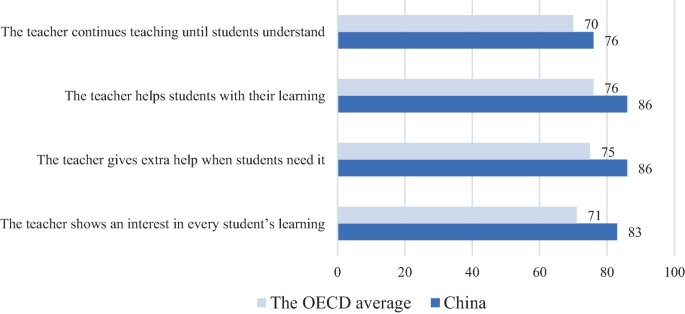
Source OECD (2019a). Notes The data for China are restricted to four relatively developed regions (Beijing, Shanghai, Jiangsu, Zhejiang)
Percentage of students who reported the following things happen in most or every lesson (%).
2.5 Students’ Cognitive Outcomes
Equipping citizens with the knowledge and skills necessary to achieve their full potential contributes to an increasingly interconnected world, and ultimately converting skills they acquired in their lives, is the ultimate goal underpinning many education systems around the world. The Program for International Student Assessment (PISA) organized by the OECD to some extent reflects how effective countries are at achieving this goal. This section compares China’s PISA performance in relation to other high performing countries, to better understand the productivity of China’s education system.
As usual, PISA 2018 measured students’ cognitive performance in reading, mathematics, and science. These three domains are considered the fundamental skills for students to strive in the twenty-first century world. Through the comparison, it is evident that Chinese students’ performance is above the average level of OECD countries. The data also show that China has a remarkably large proportion of high-performing students and lower proportion of low-achievers than the OECD average, which indicates that the high performance of China in PISA is driven by a general excellence of its students and does not just rely on top-performers. It can be argued that China’s education system has a high capacity to nurture excellence while also ensuring minimum standards. However, as the data are restricted to Beijing, Shanghai, Jiangsu, Zhejiang, this interpretation cannot be applied to all regions (Figs. 15 16 and 17).
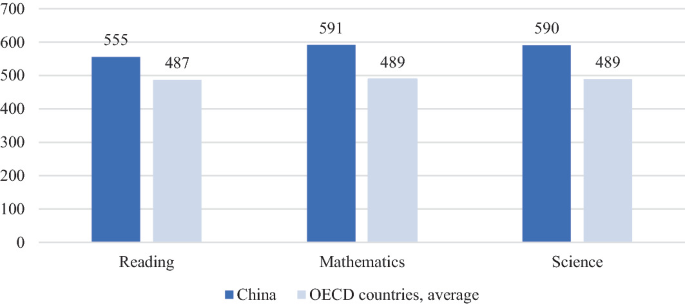
Source OECD (2019a). Notes The data for China are restricted to four relatively developed regions (Beijing, Shanghai, Jiangsu, Zhejiang)
Average performance in PISA 2018.
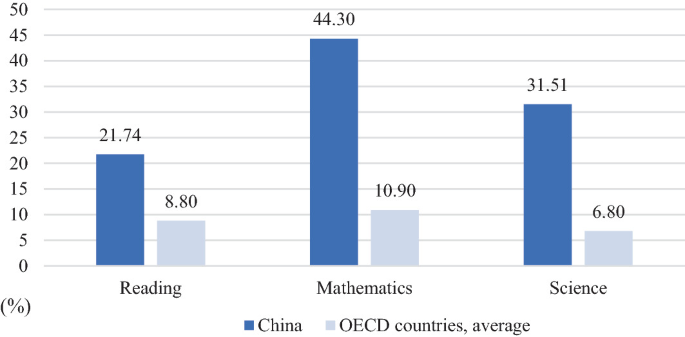
Source OECD (2019a). Notes The data for China are restricted to four relatively developed regions (Beijing, Shanghai, Jiangsu, Zhejiang)
Percentage of low performing students in PISA 2018 (%).
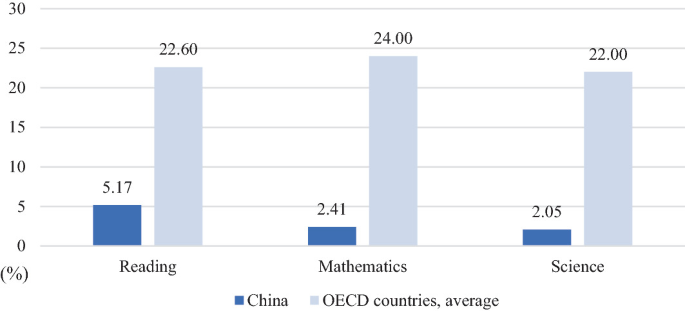
Source OECD (2019a). Notes The data for China are restricted to four relatively developed regions (Beijing, Shanghai, Jiangsu, Zhejiang)
Percentage of high performing students in PISA 2018 (%).
2.6 Non-cognitive Outcomes
The above cognitive performance only represents one aspect of education success. It is increasingly important to realize that academic achievement alone is far from enough to capture the development of students and the quality of education systems. Many education reform frameworks have prioritized the development of students’ non-cognitive skills, such as social-emotional skills, mental well-being, physical well-being (e.g., China, Singapore, UNESCO, OECD). PISA 2015 and 2018 have assessed to some extent the non-cognitive aspects of student performance, which sheds lights into the efficacy of China’s education system in promoting students’ holistic development. Figure 18 presents students’ motivation and attitudes towards competition and school-work related anxiety. A substantial body of research showed that students’ motivation has explicit relation with students’ academic performance, learning behaviors and mental well-being (Howard et al., 2021; Seifert, 2004; Thelk et al., 2009), which is a non-ignorable aspect of students’ fundamental non-cognitive competencies.
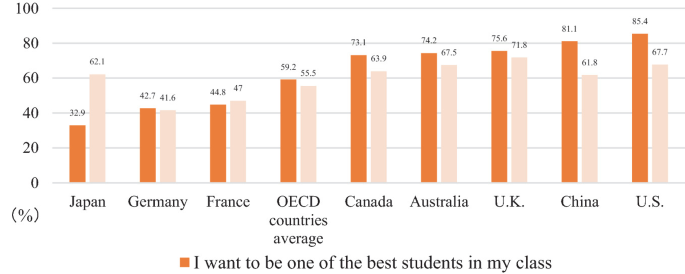
Source OECD (2016). Notes The data for China are restricted to four relatively developed regions (Beijing, Shanghai, Jiangsu, Zhejiang)
Percentage of students who agreed or strongly agreed the following statements (%).
Figure 18 shows how Chinese students feel motivated to achieve in their learning. About 80% of Chinese students agreed or strongly agreed with the statement “I want to be one of the best students in my class”. Students in the U.S. also demonstrated a high motivation for excellence. Students’ high motivation can have nurturing effects on students’ mental well-being, but when this motivation is driven by external pressure such as a high-stakes test, students are likely to experience mental-illness. It is observed that in many countries where students demonstrated a high achievement motivation, their students also tend to experience schoolwork-related anxiety. However, this does not seem to be the case in China. While many Chinese students demonstrated a very high achievement motivation, less students experienced a schoolwork-related anxiety such as feeling anxious even when they were well prepared for a test.
3 Excellence Indicators
This section intends to develop a set of indicators that provide insights into the performance of education systems. The excellence indicators include both quantitative and qualitative indicators across four dimensions: educational resources, national standards, education performance and outcomes. A comparative analysis was conducted by benchmarking the performance of China’s education system against other global education systems. The goal is to explore a potential common ground for discussing the meaning and to enrich the concept of the excellence of the twenty-first century education systems.
This section comprises three key phases. The first section introduces the conceptual framework and methodology based on which the excellence indicators of the education systems are built. The second section presents an overall result of the excellence indicators of China and other selected countries. The third section taps into the key indicators of the excellence indicators to provide a more detailed interpretation of the data.
3.1 Design
The concept of an education system is a complex whole and contains a dynamic interplay of a wide range of factors from different dimensions. To categorize those factors and describe the education systems in a comparable manner, this chapter adopts the Input-Process-Output (IPO) model, which is widely used in system analysis to deconstruct the education system into key components and see whether those components work efficiently to achieve its goal (see Fig. 19).
Based on the IPO model, this chapter focuses on the key indicators measuring fundamental qualities of the three phrases of education systems. According to the guidance of the three theoretical phrases, the criteria used for selecting the indicators for this comparative exercise are based on:
-
Relevance and Comprehensiveness: Indicators must be relevant to the themes of the 14 sub-dimensions outlined in the framework, which are chosen to cover each dimension from comprehensive perspectives.
-
Comparability: Indicators must have comparable data across education systems, which can be collected through a valid and transparent methodology.
-
Coverage on China: Indicators must have data on China’s (or its subnational regions’) education systems. If there are equivalent data from domestic data sources, the indicator is included.
3.2 Definitions and Sources
Table 2 explains the definition of the selected indicators. Five key indicators are selected concerning the input (resources) of the education systems. The indicators A1 and A2 examine the financial resources; the indicator A3 reflects the provision of education opportunities; and the indicator A4 and A5 concern about the teaching forces in one education system. The dimensions of standard and performance are closely related to the process of one education system. For the dimension of standard, the two indicators are mainly centered on the question that how the process of education system is held accountable. Thus, the indicators B1 and B2 examine the education governance according to national standards. The dimension of performance provides a general view into students’ cognitive performance at the compulsory education level. The dimension of outcome is captured by two indicators, which intend to reflect an overall picture of its effectiveness to accommodate students in its education system.
This comparative analysis focuses primarily on the existing evidence at the international level, and includes three strands of evidence: administrative data collected from major international organizations, international projects or surveys in which Chinese jurisdictions have participated, and data on China from national statistics.
For quantitative indicators, data are calculated for each country. The standardization method is used to standardize the highest value to 100 while the rest of values are scaled accordingly. After completing data standardization, the sum of the value of each indicator is calculated. Next, the highest value among the sum numbers is standardized to 100 whereas the rest of the values are scaled correspondingly. As a result of this process, the final excellence indicators are produced.
3.3 Findings
Excellence indicators attempt to provide a systematic comparison that reflects to some extent the quality of the education system. Through the calculation, the final finding shows that China’s education has relative strengths in its education governance, however, improvement is still needed in terms of education resources, student performance, and education outcome. Australia and Singapore are the two leading education systems with little score difference in all education dimensions, ranking at the top in this comparison.
Among the selected education systems, China scores the lowest in the final excellence indicators. It is observed that China’s education system demonstrates the strength in terms of education governance, by implementing a highly-structured national standard to regularly monitor the education quality. Different from the PISA test which only includes four Chinese regions, the excellence indicators selected in this chapter mostly represent China as a whole. Therefore, some indicators of China are not necessarily as remarkable as shown in the PISA study. For example, the student performance is lower when Chinese students are sampled as a whole, indicating there are noticeable differences of student performance across the Chinese provinces. This result contributes to the understanding of the overall quality of China’s education system, and highlights the needs for China to continue its education reform for further improvement of its education system from a holistic perspective.
3.4 Discussions
3.4.1 National Investment in Its Education System (Indicator A1 and A2)
Financial resources are foundational to building a quality learning environment. The extent to which a country invests in education directly not only affects its citizens—affecting student enrollment, student school life and teachers’ working conditions—but also profoundly enhances the productivity of a society, leading to long-term socio-economic benefits.
Indicators A1 and A2 focus on the financial resources available in the education systems. Indicator A1 shows government expenditure on education as a percentage of GDP, which provides a general look at how much of the national wealth is devoted to the education system and reflects the extent to which a government prioritizes its education as a function over the country’s other functions. Indicator A2 measures the expenditure on education as a percentage of total government expenditure. It gives more focus on the extent of government commitment to provide quality education services to its citizens (Figs. 20 and 21).
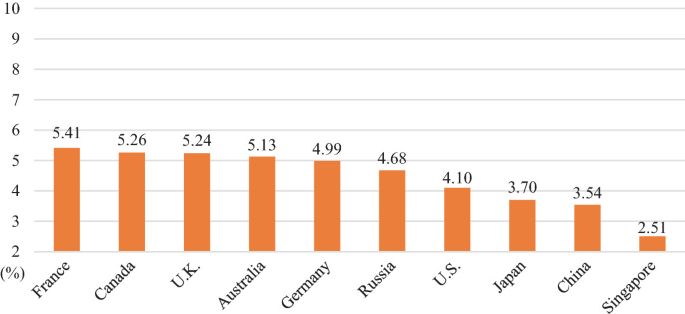
Source Adapted from UIS (2020)
Government expenditure on education as percentage of GDP (%).
3.4.2 Access to Basic Education Opportunities (Indicator A3)
The Article 13 of International Covenant on Economic, Social and Cultural Rights ensures the right to free education as the basic human right that every government should fulfill. The number of years of compulsory elementary and secondary education reflects, to some extent, the educational opportunities provided by the government, which is closely related to the equity and quality in education. Compulsory education means providing reasonable years of education to all people, which is often protected by law. Nearly all the education systems around the world impose compulsory education on its citizens. The length of compulsory education can indicate minimal education services that a person is able to receive. Elementary education and secondary education lay the foundation for an individual to develop basic skills and competencies to live in the society. The indicator A3 examines the length of the compulsory elementary and secondary education guaranteed in the legal framework, which provides a look into the education opportunities available to all citizens (Fig. 22).
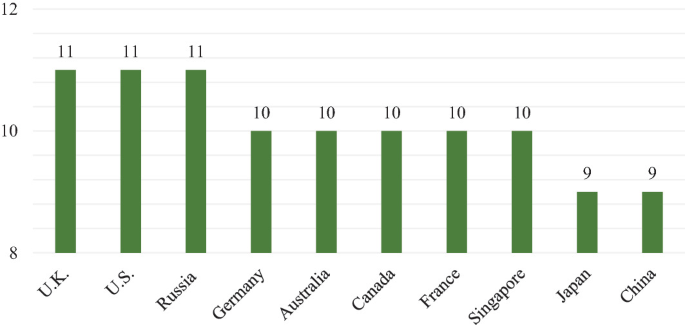
Source Adapted from UIS (2020)
Number of years of compulsory elementary and secondary education guaranteed in legal framework (%).
3.4.3 Teaching Workforce (Indicators A4 and A5)
The quality of an education system relies largely on the quality of teachers. Adequate supply and retention of highly qualified professional teachers are the prerequisites to sustain quality learning opportunities through which students can receive trustworthy supports.
The indicators A4 and A5 primarily analyze the quantity and quality of the teaching workforce in the education system. Indicator A4 shows the number of students for every teacher, which provides insights into the adequacy of teachers and the workload that teachers may take in an education system. This indicator can reflect whether students in the education system can receive adequate supports from teachers. The higher the student–teacher ratio is, the lower the relative access of students to teachers is. Low student–teacher ratio tends to associate with students’ greater academic achievement (Hattie, 2009). However, a lower student–teacher ratio does not necessarily mean a smaller class size. The distribution of teachers also influences the class size. In the indicator A4, Canada tends to have the highest student–teacher ratio, which suggests that teachers in Canada may work with more students than their colleagues in other compared education systems.
Indicator A5 examines the quality of the teaching force by calculating the proportion of teachers who have obtained the bachelor's or equivalent degrees above. This indicator calculates the percentage of teachers received a tertiary education at the lower secondary education level. The general assumption is that the higher education attainment can reflect to some extent teachers’ quality. It is observed that at least 70% of teachers in all education systems have achieved bachelor’s degree or above. Compared to other selected education systems, Chinese teachers’ education attainment is relatively low (Fig. 23).

Source Adapted from UIS (2020)
Student–teacher ratio (secondary education).
3.4.4 Accountability (Indicators B1 and B2)
A data-driven and robust accountability culture with adequate assessments can support countries in monitoring and evaluating the overall performance of their education systems, which further allows them to ensure that their education systems are developing towards achieving the overarching education goals.
Indicator B1 and B2 explore how education systems are held accountable by examining national policies and government standards. The indicator B1 examines whether there is a data-driven education governance infrastructure which regularly informs the government of the education system performance. This indicator evaluates whether a national or cross-national assessment of learning outcomes was conducted in the last five years in (a) reading, writing or language, and (b) mathematics at the following stages of education:
-
in the Grade 2/3 in the elementary education.
-
at the end of elementary education.
-
at the end of secondary education.
This indicator examines the national standards for setting up a nationally representative learning assessment, which examines whether there is a system-level monitoring infrastructure in the education systems. The existence of such a practice shows that there is a national-level practice to monitor the performance of its education system. It is observed that most of the selected education systems have set up national learning assessments to collect information about the performance of their education systems. Such assessment typically takes place at the end of elementary education and the secondary education. Some education systems also conduct learning assessment in Grade 2 or Grade 3 at the primary education level.
Indicator B2 explores the accountability of education systems at the school level. It examines the frequencies of school inspection as regulated in its national standard. A clear regulation of school inspection suggests that there is a clear governance practice set up for holding school accountable. However, lacking regulation in the national standard does not necessarily mean there is no effort to ensure school accountability. It may be due to the decentralization of education governance in which school inspection is not required at the national level. School inspection is a common approach that is employed by many education systems to gain up-to-date information about school performance and to hold the schools accountable for students and parents. It is observed that many of the selected education systems conduct school inspection once every three years. China organizes annual inspections based upon national regulations/policies. Some education systems have no specific requirements for the frequency of school inspection, such as those of Russia and France (Figs. 24 and 25).
3.4.5 Student Cognitive Performance (Indicator C1)
Fostering students’ cognitive performance is one of the crucial objectives of education systems. Comparing students’ academic achievement on specific cognitive subjects provides an easy way to understand the performance across different education systems. Mathematics and reading are recognized as the basic subjects that are necessary for preparing the core competencies that students need for the future (OECD, 1999). Indicator C1 presents the proportion of lower secondary students who have reached the minimum proficiency level in the domain of mathematics and reading of the selected education systems. Specifically, this indicator measures the proportion of children within the ages of lower secondary education that have reached the minimum proficiency level in the domain of mathematics and reading. This indicator reflects the efficiency of the education system in terms of equipping its students with the necessary skills to strive for the future. A higher proportion suggests that the education system has a higher efficiency in preparing its students with the necessary cognitive skills. Around 70% of the lower secondary students in China have achieved the minimum proficiency required at the national level in mathematics and reading. A higher share is observed in many other education systems, among which, Singapore’s education system prepares the highest percentage of students by equipping almost 90% of lower secondary education students with necessary mathematics and reading proficiency (Fig. 26).
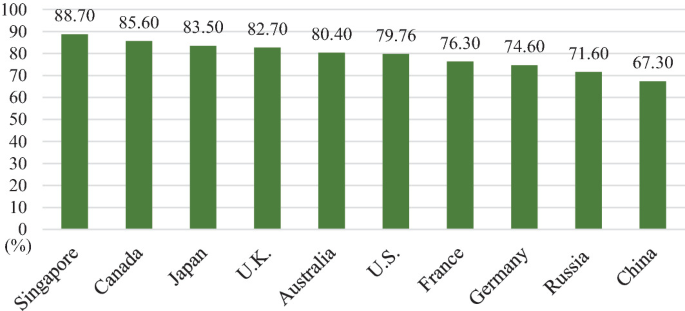
Source Adapted from UIS (2020)
Proportion of children at the age of lower secondary education prepared for the future (%).
3.4.6 General Performance (Indicator C2 and C3)
Whether students have adequate opportunity to advance from the basic education to the tertiary education is one of the important aspects that reflect the effectiveness of education system. Examining the enrollment and graduation ratio for tertiary education provides information on the proportion of students who succeed in moving all the way up to the tertiary education and eventually complete the tertiary education (Fig. 27 and 28).
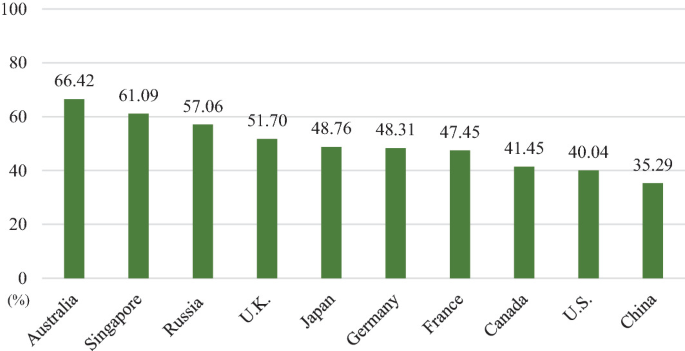
Source Adapted from UIS (2020)
Gross enrollment ratio for tertiary education (%).
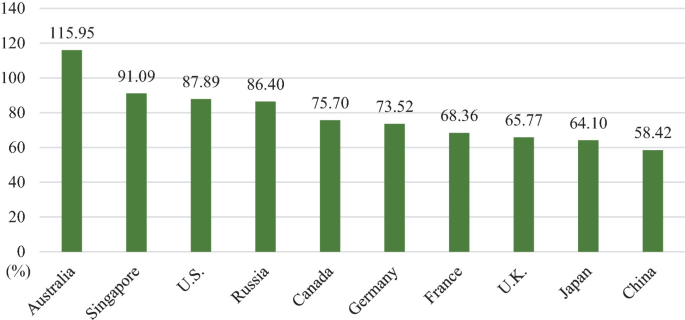
Source Adapted from UIS (2020)
Gross graduation ratio for tertiary education (%).
4 Best Practices
This section draws on influential education practices happening in contemporary China in the context of globalization. It focuses on China’s practices on broadening children’s access to basic education and international collaboration. This section starts with introducing the Project Hope (Xiwang Gongcheng), a non-profitable education project with far-reaching effects on China’s education history. The analysis then compares the Project Hope with the global education movement “Education for All” and presents a full picture of how the international community works together towards ensuring every citizen has access to education. This section also highlights recent practices of how China has participated in global education development.
4.1 Sowing the Seeds of Hope to Children in Poverty
Students’ universal access to basic education has improved tremendously in the past decades. Before the economic reform in the 1980s, education in China was still far from achieving the goal of universal access. In 1965, there were merely three million students enrolled in lower secondary education. Despite limited economic capacity, the Chinese government was committed to improving poor education conditions. In 1980, the government set the goal of universalizing elementary education by the end of the 1980s and universalizing the implementation of nine-year compulsory education in the 1990s. This commitment was further enhanced by the Compulsory Education Law published in 1986 (National People’s Congress, 1986). It turns out that the Chinese government commitment to universalizing the basic education was not a pie in the sky. With continuous efforts through the decades, by the year of 2020, the participation in education in China has witnessed a remarkable increase. Taking the enrollment rate in the lower secondary education as an example, the rate soared to almost eight times what it was in 1965. Through this process, the government explored a set of effective policies and practices which allowed China to realize the goal of education universalization in a short period of time. One of the most up-lifting practices is Project Hope. The following content presents a sketch of this project and it is expected that these practices can shed lights into the progresses of education reform in contemporary China.
Project Hope is one of the most influential education charity events in China’s non-governmental organization history. The primary aim of this project is to support children from poverty-stricken rural areas to complete the basic education. When the project was established, China was still a low-income country, facing a shortage of education fundings. Many children in poverty-stricken areas were not able to receive basic education. Statistics reported that more than 30 million children between the ages of 6 to 14 were unable to attend school or were forced to drop out. 84% of them were coming from the rural areas (China Youth University of Political Studies, 2010). Each year, there were one million children deprived of education because of poverty (Zhongguowang, 2004).
The Communist Youth League, a governmental body, and China Youth Development Foundation, a non-government organization, launched the Project Hope, with the overarching goal of ensuring that all Chinese children can enjoy the basic right to education. The project seeks to accomplish its goals through the following methods: setting up a grant-in-aid program to help drop-out students return to schools; building schools in poverty-stricken areas; providing teaching supports, pedagogical materials and textbooks; and providing special education funds for outstanding students in impoverished areas to go into tertiary education.
Project Hope has been a great success in China. Statistics show, by 2019, this project had received donations of US$2.16 billion dollars, which has helped millions of families and supported over 5.99 million students who had financial difficulties. A total of 20,195 elementary schools have been built, which continue to provide education to children in impoverished areas (Xinhua, 2019). The social influence of Project Hope is also remarkable. In 2010, a survey conducted by China Youth University of Political Studies showed that over 90% of Chinese citizens have “heard of” or “know in detail” about the Project Hope (China Youth University of Political Studies, 2010).
As it is one of earliest and the most successful non-profit movements in Chinese history, it has inspired an explosion of contribution in education by Chinese non-government organizations, which focuses on various pressing social issues, such as education, health care, environment (Ross, 2006; Stalley & Yang, 2006). A study surveyed over 1,500 project-sponsored students and found over 90% of them reported that this project has profoundly shaped their life values and raised their awareness to take part in public service activities (China Youth University of Political Studies, 2010).
4.2 Providing Education to Every Child
By the end of the twentieth century, the world had become increasingly integrated and globalized. It was in the dearth of building a sustainable development mechanism for the upcoming twenty-first century that education took on the responsibilities of preparing every citizen for work and life in a new era. However, by 1999, there was still a significant portion of uneducated population globally. In this context, the concept of “education for all” (EFA) emerged as the fundamental approach to guide the development of the global education reform. The right to education has been recognized as one of the basic human rights in the twenty-first century. The global community put forward the concept of education for all, which Hulme (2007) refers as the world’s biggest promise in the form of the Millennium Development Goals (MDGs). In 2000, there are 189 countries and international partners devoted to promoting EFA in society. This section describes the main educational concept and ideology underpinning the global movement of Education for All, which aims to provide a global picture of education universalization which is similar to the process that took place in China.
EFA is a global movement led by UNESCO, aiming to achieve the basic right of education for every citizen in every society. This movement was officially announced through the Dakar Framework in 2000 at the World Education Forum in Senegal, Africa. 164 countries have participated and committed to fulfil the EFA goal by 2015 (UNESCO, 1996) including China. This global movement took place in a setting where children in many countries were not able to attend schools, millions of adults were illiterate, and one in three adult women in the world cannot read or write. Under this circumstance, the following seven goals of the EFA have been established:
-
Expand early childhood care and education
-
Provide free and compulsory elementary education for all
-
Promote learning and life skills for young people and adults
-
Increase adult literacy by 50 percent
-
Achieve gender parity by 2005, gender equality by 2015
-
Improve the quality of education
-
Develop the Education for All Development Index (EDI) by UNESCO
With the development of EDI, the international community was able to monitor progress towards the above goals. As of 2015 there has been notable progress towards several goals. Students enrolled in pre-elementary education in 2012 have tripled when compared to 1999. The elementary education enrollment has jumped from 83% in 1999 to 93% in 2015. Participation in lower secondary education has increased sharply. Countries like China have seen the lower secondary gross enrollment ratio increased by at least 25 percentage points. Globally, the literacy rate has risen. More than two thirds of the countries have achieved the gender parity at the elementary education level. Many countries have raised their spending by at least one percentage point of national income (UNESCO, 2015).
However, the indicators also reveal that the political commitment for EFA has not been fully achieved and challenges still remain. Globally, one in four children still suffer from a chronic deficiency in essential nutrients. In sub-Saharan Africa, at least one in every five students could not complete the elementary education demonstrating that educational gaps continue to persist. In countries like Philippines, students from the poorest families have fewer opportunities than their economic-advantaged peers to participate in lower secondary education. Additional goal to increase adult literacy by 50 percent remains unachieved; and less than 75% of elementary school teachers have trained to meet national standards (UNESCO, 2015).
These indicators suggest that if the current trend of education development continues, the targets of the EFA will not be fulfilled in the future. This result also indicates the pressing need to uphold the international partnership for building continuous systematic supports for global education. Meanwhile, under the influence of the fast-evolving technology and the increasing uncertainty in the world economy and politics, exploring effective and innovative approaches and mechanisms is needed to help transfer the politic commitment into tangible support for education. Given this need, China has provided a few exemplary examples of international cooperation in promoting global education development.
4.3 South-South Cooperation in Education
South-South cooperation means the international cooperation among developing countries in the global South. The distinction between “North” and “South”, rather than geographical location, refers to the social, economic and political differences that exist between developed countries (Global North) and developing countries (Global South). Traditionally, education cooperation often takes the form of North–South 333cooperation, through which the developed countries provide educational resources or other related supports to the less developed countries. However, as the North countries rarely share the same economic or political factors as the South and have rarely experienced the similar challenges in education systems as the South countries, the North–South cooperation may not accurately address the priorities and needs of the developing countries (Matos, 1999). South-South cooperation, therefore, is deemed as a complementary approach to international cooperation to facilitate knowledge, policies and knowledge sharing among developing countries (Gray & Gills, 2016). Evidence shows that Southern countries have contributed to more than half of the world’s growth in recent years, and the outflow of foreign investment from Southern countries represents a third of the global flows. China is one of the Southern countries that is developing quickly in many domains and contributes to the overall global development.
For decades, China has long been on the beneficiary side from the North–South cooperation for education development. In recent decades, the education development in China has gradually drawn the world’s attention. Since PISA began its world benchmarking efforts in 2003, China and its subregions have constantly scored as one of the best performing countries. Similar outstanding results were reported in the subsequent TALIS (Teaching and Learning International Survey). The project manager of TALIS, Karine Tremblay, remarked that many initiatives concerning teachers’ professional development implemented in Shanghai, China, could serve as global model (Cao, 2017). With the increasing recognition of its education performance in the global community, China has actively engaged in international exchange and cooperation on educational affairs.
One of the noteworthy practices is the establishment of the UNESCO category II centersFootnote 2in China, which shows China’s initiatives in joining in the global network of international cooperation for education. Two category II centers have been established, taking into the advantages of educational resources of the local regions. The major functions of these centers are focused on knowledge production, capacity building, technical service and information sharing (UNESCO, 2022). Depending on the specific domains in education, the category II centers have strengths and serve for different purposes. The two centers in China are the Teacher Education Center in Shanghai and the International Center for Higher Education Innovation (ICHEI) in Shenzhen. Both centers have leveraged the advantages of the educational and other resources in Shanghai and Shenzhen, respectively. The following sections highlights the functions of the two centers.
4.3.1 Leveraging the ICT Capacity in Education Cooperation
ICHEI is based in Shenzhen, the city which is the home to many world-class leading technological enterprises such as Alibaba and Tencent. The Center has taken advantages of the city’s resources, in combination with the strength of China’s quickly expanding higher education system and the lessons learned from the advancement of the education innovation in the Asia–Pacific regions. Together, it promotes the use of the information and communication technologies (ICTs) in supporting higher education in developing countries. One of the seminal works produced by the center is the international institute of online education, which equips teachers with essential skills for online training and provides higher education institutions several ICT tools (UNESCO-ICHEI, 2022). This program has successfully built partnerships with dozens of higher education institutions in African and Asian countries.
4.3.2 International Cooperation on Teacher Professional Development
With the outstanding performance of its students in PISA and its teachers in TALIS studies, Shanghai has won the world’s attention as one of the most high-performing education systems in the world. International research and studies, with attempts to decipher the excellence of Shanghai education, have concluded that teachers are the most fundamental elements to the success of Shanghai students in PISA tests. The Teacher Education Center, which is another category II center under the auspices of UNESCO, was established under this background. It is in collaboration with Shanghai Normal University, a municipal-level university focusing on teacher training. The main purpose of this center is to be a service provider, standard setter, and a research and resource management center in the field of teacher education beyond the context of China. The functions of the center revolve around four perspectives: producing knowledge in teacher education; designing programs for teacher training; providing ICT supports to teacher education in underdeveloped countries; and sharing information with others UNESCO bodies (Cao, 2017). China’s practices in South-South cooperation provide an example of how to leverage the local advantages and share resources to support the educational needs of other southern countries. As a result, this practice built a synergy for enriching the global knowledge and experiences for education development.
5 Inspiring Stories
This section presents two true and up-lifting stories that happened in the history of China’s education: they focus on the inspiring individuals that have engaged in and made impressive contributions to China’s education development. While this section tries to reflect Chinese education from an individual perspective, it also shares encouraging messages on promoting education development.
5.1 Su Mingjuan: Carrying Hope and Giving Back to the Community
In 1991, like many children who lived in rural China, Su Mingjuan struggled to gain opportunities to participate in education. She was a village girl born in a peasant family in a poverty-stricken village, situated in a remote mountainous area in Anhui, a province in central China. Although access to basic education was already guaranteed by law at that time, for families who lived below the poverty line, the additional burdens of paying fees for books and incidental expenses were out of reach for many families. This was also the case for Su.
Su’s family could barely afford to pay RMB100 yuan (less than US$20 dollars) to send Su to the school. Su faced even further challenges when her father, her families primary bread winner, suffered injuries at work, forcing Su to withdraw from school. In this helpless moment, a turning point happened and changed Su’s destiny.
A volunteer photographer from the Project Hope visited Su’s village and tried to take photos of children and poor conditions of schools in the poverty-stricken areas, with the aim to raise the public awareness. This photographer saw shabby classrooms where there were no proper tables and chairs and their windows were without glass and only covered with thin paper. With a heavy heart, this photographer walked into one classroom and saw the children with worn clothes sitting on the benches staring back at him with curiosity.
Suddenly, his camera was attracted by a small girl, eight-year-old Su, holding a pencil that is short enough to hide in her palm. The photographer quickly clicked on the shutter and captured the moment. The photo of Su depicts the realities of many children in the poverty-stricken areas. The big eyes of Su depicted in the picture reflect the in-depth desire and hope of thousands of children for learning. Such emotions have passed on through this photo and reached the bottom of people’s hearts.
With the attentions Su’s picture brought to the Project Hope, it became well known and was able to fund more children in poverty. Because of the Project Hope, Su could go back to school and studied all the way to university. With her excellent academic performance, she has earned her degree and works in the bank in her hometown province.
As a girl living in remote mountain, Su who dropped out of school because of the poverty, was able to leave the mountains and achieve her life goals through the empowerment of education. Later on, Su decided to pay back to the society and help children who are also affected by the poverty. In 2018, Su has donated her savings and set up a student fund. She worked as a volunteer to help children with difficulties. Now, as an alumna of Project Hope, she is an active advocate for education. She actively engages in public welfare and charity with the hope of changing the destiny of more children who live in poverty.
5.2 Andreas Schleicher: Examining China’s Education from an Outsider’s Eyes
PISA is the most comprehensive worldwide international benchmarking study for education systems. It has profound impacts on global education reforms and shaped the rhetoric on teaching and learning in the twenty-first century. Andreas Schleicher is the man who initiated this revolutionary study. Andreas, a German researcher and the head of Education and Skills Directorate at OECD, has been recognized as the funder of the PISA. He has advocated throughout his life for evidence-based education policy making and believes that “PISA can help us to look beyond in the current education system” (Lin & Zhang, 2020) and promote global education reform.
When China started to participate in PISA and continuously became the top-ranking country in PISA. Andreas had received many inquiries from the public regarding the reliability of China’s PISA results, as there was skepticism about China’s outstanding performance. For instance, an American think-tank Brookings Institution posted an article named “PISA’s China problem”, which questioned how representative Shanghai’s performance was for the entire country. The article criticized PISA’s Shanghai results for deliberately hiding the results of poor students and poor schools in Shanghai (Loveless, 2013). As the first person responsible for PISA, Andreas has engaged in this debate with the Brookings Institute. His provocative response letter back was titled, “are the Chinese cheating in PISA or are we cheating ourselves?” Andreas’s essay began by pointing out a disturbing phenomenon long existing in international medias.
Whenever an American or European wins an Olympic gold medal, we cheer them as heroes. When a Chinese does, the first reflex seems to be that they must have been doping; or if that’s taking it too far, that it must have resulted from inhumane training (Schleicher, 2013).
Although there are detailed technical note provided to justify the validity and reliability of Shanghai data published by OECD, Andreas was still surprised that many criticisms were groundless and did not even look at the official documents that already addressed their concerns. One of the major criticisms of PISA’s China performance was the internal immigrant problem. International stereotype was that the house registration system in China restricted children from rural areas from gaining access to education in Shanghai. However, this was no longer the case. In fact, China had changed this policy long before opening up the education opportunities for immigrant children. When PISA 2012 was conducted, the coverage of immigrant children in Shanghai was the same as all other countries. This stereotype held by the international community is engendered from long-time misinformation.
Andreas accurately sensed this misunderstanding long existed between China and the West. As a researcher himself, he has always believed in empirical evidence over second-handed opinions. To better understand Shanghai and China’s education systems, he visited China many times, going to local schools and observing China’s education system through his own eyes. With the information he gained, Andreas developed more in-depth and critical insights into China’s excellent academic results. One of the advantages featured in China’s education system is the equity of learning despite students’ backgrounds. He has observed that “the four provinces (Beijing, Shanghai, Jiangsu, and Zhejiang) tested in PISA have made teaching as a profession very attractive” (Edwards, 2019). He noticed and shared that Shanghai’s system has the capacity to attract well-qualified teachers to top schools, which provides disadvantaged students at these schools a greater chance to accelerate their learning. According to his experiences in remote areas in Yunnan, Andreas observed that students there also received good-quality education. It was through close observation and fieldwork-based research that Andreas developed a more comprehensive and objective understanding of China’s education systems, which allowed him to see both its strengths and deficits.
Academic achievement is one strength reflected in China’s PISA results. However, Andreas pointed out that the non-cognitive skills of students in China and expressed concerns. Additionally, in the PISA 2018, Andreas pointed out that Chinese students showed less satisfaction with life compared to their peers in other OECD countries. Anyone who has experienced China’s education systems would notice its competitive exam-oriented culture and Andreas observed this too. He further commented on the prevalent exam-oriented culture in China, saying that “the exam is just one of many ways to verify learning. It is about whether you can think like a scientist or mathematician, translate a real-world problem into a mathematical solving, interpret the result back in the problem context”. When he was asked to give suggestions to Chinese education policymakers for the future education reform, he commented with a simple phrase “learn a little less for the exam, a little more for life” (Lin & Zhang, 2020). This story reflects the misunderstanding towards China’s PISA performance in the global community. Rigorous research is needed to explore the Chinese education myth under the PISA statistics and reveal the mechanism of China’s education. Only through this, can the PISA test bring more meaningful discussions for global education reform rather than just a simple comparison.
6 Latest Research
This section presents an outline of the existing literature on education system reform and development with focus given to Chinese contexts. Bibliometric analysis was used to map existing research on education systems. Quantitative results from the bibliometric analysis are presented, highlighting emerging themes and research trends. Finally, a comparison between Chinese literature and international literature in this domain is reviewed, providing recommendations and suggestions for future research.
6.1 General Overview
By collecting data from the China National Knowledge Infrastructure (CNKI) platform, a citation analysis is conducted for all Social Science Citation Index (SSCI) articles relevant to education systems. Articles are selected and screened based on the following criteria:
-
Papers were published between 2012 and 2022;
-
Article theme must be concerned with education system reform;
-
Papers must be situated in the academic field of education research;
-
Papers must relate to basic education, and tertiary education related articles are excluded
-
Papers are published in academic journals indexed by PKU (Peking University Core journals) or CSSCI (Chinese Social Science Citation Index).
Through citation analysis, key sub-themes were identified (see Fig. 29).
A total of 10,690 published articles meeting the inclusion criteria have been identified. From 2012 to 2022, there have been a steady amount of academic research relevant to the topic of education system reform. Approximately 1,000 research articles have been published annually. The most commonly identified themes include education theory and management, vocational education, teaching and Learning reform, and secondary education. Four additional emerging themes are also found in the current Chinese literature, including continuing education, early childhood education, primary education, and talent cultivation.
By leveraging word cloud analysis of international literature indexed in Web of Science (WOS) social science citation index database, 20 frequently used keywords appeared in the themes of the selected literature for education system research. The majority of the current international research on education system research is centered on higher education, which matches the patterns shown in Chinese literature. In addition, distance education and teacher education also appear to be the popular research topics that attracted many researchers’ attention. However, there is also a portion of literature devoted to international development topics such as inclusive education and sustainable development, which signifies the importance of a global perspective in the research of education systems. Noticeably, China’s education system has drawn much attention of the international research community and emerged as a popular research topic. Two research designs appear most frequently, which include case studies and systematic reviews. These two research methods are also used widely by Chinese researchers. A case study is most often used by researchers to explore policy and best practices of education system reforms based on a comparative education analysis (Fig. 30).
6.2 Current Research Focus
6.2.1 Technology-Empowered Education Reform
This section highlights one of the broad themes emerged in the literature of the education system reform – technology empowered education reform. The use of technology has brought an innovative transformation to the traditional education system in the twenty-first century. Contemporary researchers in China have devoted a large amount of interests on this topic. According to different types and uses of technology in education, the literature on this topic can be summarized into three subthemes, that is, distance Education, education informatization, and AI-empowered education.
Distance Education. Distance education has emerged as one of the major themes relevant to education system research. The literature focuses on integrating technology into education and building an innovative education system, which disrupts the traditional monotonous form of education and explores a blended form of education design. Researchers explore the potential of using different technologies to design distance education system. Cui and his colleagues (2020) explored how to use VR live broadcast technology to design a distance education system that can improve teaching efficiency. Some researchers explored the use of Web, Java and other technologies in the design of a distance education system. There is also a portion of literature that seeks to construct new conceptual theories to guide the design of a technology-enhanced education system (e.g., Feng et al., 2013; Hu et al., 2019). The concept of life-long learning serves as the fundamental conceptualization in guiding researchers discussions on the rationale and methods of promoting distance education (Zhang, 2022). Literature regarding the distance education suggested a need for more evidence-based research and a need for enriching the general theories for distance education. Meanwhile, promoting blended learning and deep learning through a distance education system is a promising area for future research to explore (Tan & Xu, 2018).
Education Informatization in Education Systems. Another theme focuses on education informatization, which emphasizes the use of communication technologies to facilitate the innovative education reform. Education Informatization 2.0 has emerged as an attractive research topic among Chinese researchers. Education Informatization 2.0 is distinctive from education informatization 1.0 which mainly focuses on qualitative changes of technological software in school systems. The education information 2.0 focuses more on transformation and innovation of education systems empowered by informatization. For example, Chinese researchers discussed building an eco-system for teaching and learning with the integration of big data and artificial intelligence. Some conceptual suggestions on how to construct an effective education system in the era of education informatization 2.0 have also been explored (Hu & Zhang, 2018; Zhang & Liu, 2020). Equivalent to the term of education informatization, “smart education” is widely used to express the similar concept in Chinese literature. Many researchers study how to build smart education systems which enable effective teaching, personalized learning, and more supportive environment (Zheng, 2018; Zhu & Hu, 2022).
Artificial Intelligence (AI) Empowered Education System. With the growth of interest in technology empowered educational reform, Artificial Intelligence (AI) has attracted the interests of many researchers. Following UNESCO’s first international meeting on AI in education in Beijing in 2019, there has been a blooming literature provided in-depth thoughts into how to build an AI empowered education system. Wu and his colleagues (2017) analyzed the current research outcomes in China by using word frequency and co-word analysis. Their research concluded that the AI education products developed by Chinese enterprises were the driving force for promoting AI empowered education reform. They further proposed a conceptual framework for an AI empowered education eco-system that encompassed the key consideration including the technical architecture, the application forms and the stakeholders. Some researchers tend to focus on AI for a specific education system, such as teacher education (Chen, 2019, 2019a, 2019b), or higher education (Li et al., 2021). Meanwhile, other researchers have adopted a comparative lens to examine best practices for the integration of AI in education systems, such as in Canada (2020), and the U.S. (Tian, 2021). Chinese literature in this domain focus principally on the technology transformation and regard it as a core driving power for the high-quality education system reform in the future.
6.2.2 Universal Access to Education
The education opportunities for students have been a core concern for Chinese policymakers and researchers. Literatures discussing China’s education reform provide extensive insights into this question. One genre of policy-based research systematically analyzed the policies that Chinese government had conducted to promote education universalization. Fan and Fan (2022) pointed out that China’s education reform for the past decades has been guided by a people-centered principle, which always upholds the interests of people. Many researchers paid particular attention to education reforms since the “opening-up” policy in 1980s, highlighting the changing priorities of government policies in promoting education universalization (Liu & Cheng, 2018; Qi & Yang, 2018). The unified development of urban and rural education has been regarded as an effective strategy that is worth to be continually upheld in China education reform.
Student access to upper secondary education is one of the most popular research areas when discussing Chinese education universalization. Many researchers highlighted the urgent need to improve the attractiveness and quality of vocational education at the upper secondary education level to achieve a well-balanced development of the education system (Li, 2015). Researcher analyzed education policies on vocational education and identified that current education reform goals are to promote the equal proportion of student enrollment in general learning and vocational learning tracks at the upper secondary education level (Li, 2021, 2021b). Improving the quality of rural education is another crucial priority for narrowing the educational gap and achieving universal access to education. Zhang (2012) identified a pattern from Chinese unique characteristics in the policies and practices carried out by the Chinese government from the past 60 years, which are still considered as meaningful for the future development of the rural education in China.
6.2.3 Education Equity
Ensuring the equity in education has been set as the fundamental principle for China’s contemporary education reform. In the past several decades, the Chinese government has put forth the new policies and practices to develop an education system with high-quality and equity development. Relevant literatures have summarized the reform experiences for ensuring education equity in China’s education history, arguing that the meaning of education equity has become more comprehensive and inclusive (Feng & Gao, 2022a, 2022b, 2022c, 2022d). With the age of globalization and informatization, the education ecosystem has been reconstructed. Researchers argued that the idea of education equity is shifting towards fulfilling the diverse learning needs of learners. This idea suggests the education system should be reformed in a way that allows for more seamless transitions of different learning tracks and pathways, so as to empower the learners to pursue individualized learning goal (Xu & Xie, 2022). In terms of policy implementation, some researchers focus on education governance in China and explore approaches to optimize the government’s capacity to monitor the equity of public education services (Li et al., 2022). Zhou and Li (2022) discussed the potential pathways to conduct a systematic education reform, which viewed the public service, teacher education and lifelong education as an integrated approach to promote education equity.
How to leverage the benefits of the information technology to promote the education equity is a question that has received growing attention in recent years. Many researchers explore the mechanism (e.g., Han, 2021), the implementation strategies (e.g., Chen & Zhang, 2012) and the practical cases (e.g., Feng et al., 2020) of using technology for equity promotion in education. From a perspective of education governance, a country’s education development is deemed as instrumental for the overall development of national education equity. Liu (2021) identified that the county education existed various forms of segregation and building county’s government capacity to connect the resources and knowledge with outside was needed to overcome such segregation. In the urban area, the problems like shadow education are also considered harmful for education equity which has raised researchers’ concerns. For example, Li (2020) analyzed the causal mechanism of shadow education problem through the lens of social science, putting forth specific strategies of how to prevent the extracurricular tutoring. In addition, some researchers highlight the problem of the high-stake test culture that has long existed in the Chinese education system and point out the need to reform such culture to better support the economically and socially disadvantaged students (Lu & Chu, 2017; Qi & Tang, 2016).
6.3 Research Trends
6.3.1 Leveraging the Benefits of Technology to Improve Underdeveloped Education Areas
Vocational education has long been an underdeveloped education area, which needs urgent intervention to improve its overall quality and attractiveness for students and their parents. With the growing acknowledgement of the benefits of using technology for empowering education system reforms, a growing number of researches study recent education reforms in vocational education. Exploring how to leverage the role of technology for improving the quality of vocational education has emerged as an identical trend in current Chinese academic research. Some researchers focused on the curriculum and pedagogical reforms enabled by the ICT-related technology (e.g., Gao, 2015; Yang, 2018) while other researchers focus on specific case studies to unearth the potential rules or principles for guiding technology used for improving vocational education (e.g., Chen, Y., 2019; Zhang et al., 2019). In addition to vocational education, other underdeveloped education areas including career education (e.g., Qi & Wang, 2021), entrepreneurship education (e.g., Wang, 2022), adult education (e.g., Feng & Cheng, 2020), have also emerged as relatively new focused areas in Chinese literatures discussing the role of technology in the process of education reform.
6.3.2 Increasing Focus on High-Quality Development to Strengthen Education Access
With the rapid development of universal access of compulsory education in China over the past decades, the needs of education reform gradually moved from broadening public access to compulsory education towards providing high-quality education services to the people. A growing number of researches have paid attentions to upper secondary education and extends the scope of education universalization beyond the compulsory education. While student enrollment in upper secondary education is booming in China, Chinese researchers identified a number of existing problems, such as shortages of qualified teachers, a widening gap in student performance, the governance challenges in large-scaled schools (e.g., Liu & He, 2016; Shi & Zhu, 2015). They explored the potential strategies for education reform, including a systematic reform approach that integrates teaching, assessment and recruitment (Sang & Xu, 2021); a comparative model guiding the distinctive reform between vocational and general learning tracks (Liu, 2020); and a potential solution to break the binary of vocational and general learning divisions (Chang, 2020). Likewise, research trends on the quality development in the process of education universalization also extend to the early childhood education stages. Researchers not only discussed the management (Hu, 2021), the curriculum (Li & Fan, 2020) and teaching methods (Wen, 2020) of the early childhood education reform, but also shed lights on early childhood education development in the rural areas and socially disadvantaged groups (Li, 2019).
6.3.3 Growing Emphasis on Building a Well-Balanced, Inclusive and Equitable Education System
During the past decades, education equity at the basic education level has improved dramatically in China. However, there are still many pressing issues endangering the quality of its basic education, such as students’ academic burden, exam-oriented culture, and poor management of private education services (Xu, 2015). These real problems matter to the interests of all citizens, which urge Chinese researchers to conduct more in-depth research to explore the possible solutions. One emerging research trends concerns the modernization of the governance of education quality. Chinese researchers explore how to build an education governance infrastructure so that the quality of basic education can be monitored with scientifically methods (e.g., Tian et al., 2022; Li & Li, 2021, 2021b). Song and his colleagues (2021) proposed the idea of leveraging the benefits of big data to drive the reform of basic education evaluation. Such research focuses on data-driven governance is in line with the global education governance reform, which places values on evidence-based policymaking and management (Zheng & Yu, 2022). Another emerging trend in the research related to education equity is the focus on the policy agenda of alleviating students’ homework burden (“Double Reduction” policy). Researchers started to discuss how to reshape the current academic oriented education system towards a more inclusive education that accommodates increasing diverse needs of learners, with the overall goal of achieving both high-quality development and the education equity (Fan, 2021; Dong & Li, 2022a, 2022b, 2022c, 2022d; Liu, 2022).
7 National Policies
This section introduces some innovative national Chinese educational policies. These policies reflect the trends of current education reforms that China’s education systems are being shaped towards. The long-term goals depicted in these policies outline a blueprint for China’s future education development, which shed lights on the future society and citizens that China aims to develop. This section highlights the latest education policies that are fundamental for international researchers to interpret China’s education context.
7.1 Fundamental Policies on Education System Reform
Building a future-ready education system has long been a priority concern of the education reforms around the world. With a world facing rapid changes in technology and an increasing uncertainty of the global environment, how to prepare their citizens so that they can strive to live in an uncertain world appears to be a fundamental question when planning education reforms. Future education largely depends on the guidance of the national policies. China has oriented education reforms towards he modernization ever since its opening up in 1978. The overall goal of reforms is to ensure the equal participation of every child in education. During the past decades, the participation rate of Chinese children in compulsory education has soared. The goal of providing universal access to education has been achieved, from the perspective of participation rates. With economic growth, China is no longer a “poor country running big education” rather it is shifting towards a “great country building strong education” (Zhu, 2019). A strong education system requires more than just achieving universal participation rates. The following subsections introduce the latest national education policies carried out in China. These policies determine the directions of China’s current education reforms and depict the outlines of future education and the competencies of future citizens in China. The following content introduces the fundamental and cutting-edged educational policies that lay a solid foundation for the education development in the twenty-first century.
7.1.1 Constructing a Supportive Learning Environment
China has dedicated to providing a supportive learning environment. Following are the typical policies demonstrating Chinese efforts in doing so.
Online Learning. Since 2000, China has launched the basic education informatization plan. With the growing recognition of technologies’ roles in education, China’s central government published a policy entitled Guidelines on Strengthening the Construction and Application of Online Education and Teaching Resources in Elementary and Secondary Schools (MOE et al., 2021). This policy proposed five crucial initiatives:
-
Construct a multi-scaled online learning platform that coordinates national, provincial, municipal, county and school-level platform
-
Develop high-quality online learning resources
-
Make full use of the online learning platform in the education process
-
Improve teachers’ and students’ information literacy
-
Improve policy governance on informatization in education
Preventing School Bullying. To strength a healthy school climate and protect the physical safety of the students, MOE published Provisions on the Protection of Minors by Schools (MOE, 2021a), which lays out regulations to address the potential safety issues in schools, including establishing a special protection system to prevent school bullying, specifying the regulation to prevent, educate and intervene in school bullying, improving the prevention measures towards sexual harassment.
Controlling the Use of Mobile Devices. With the pervasion of the mobile devices, the disadvantages of using phones in student development and school management have also been observed. To prevent students from overusing mobile phones, Notice on Strengthening the Management of Mobile Phones for Elementary and Secondary School Students has been published (MOE, 2021b), which requires that students in elementary and secondary education shall not bring their personal phones to school. When students have an absolute need to bring the phone, parents’ permission is required. Schools must set out detailed rules to control students’ use of mobile phones. The cooperation between schools and families is needed to provide a consistent guidance for students to use mobile phone wisely.
Family Education. China’s education policy further extends its scope to home education and sets a framework to regulate the home education environment. The new law on family education promotion was put in place in 2022 (National People’s Congress, 2021), which is the first law in China’s education history to provide a clear legal framework for family education. This law has outlined parents’ role as the guardians for their children’s education at home and emphasizes the guardians’ responsibility to arrange the time for children’s learning, entertaining and exercises. Reducing children’s academic burden and protecting them from internet addiction is emphasized in this law.
7.1.2 Promoting Quality Teaching and Learning
Promoting quality teaching and learning is another goal China has always strived to achieve. The following are the typical policies demonstrating Chinese efforts in doing so.
Reducing the Academic Burden. To protect students’ well-rounded development and promote students’ mental health and well-being, China issued a policy aiming to reduce students’ homework and extracurricular training on subjects like Chinese, math and English (the State Council, 2021). It is officially required that the intensity and length of the homework should be reduced for compulsory education students. Schools must improve the quality of homework and provide guidance for students’ homework. Schools should consider extending the after-course tutoring services to meet the diverse learning needs of students. This policy also set out the regulation for private supplementary tutoring services out of schools. To enhance the quality of school-based tutoring service, the policy further lays out the concrete measures, such as expanding the teaching force, increasing the financial subsidies for teachers, and controlling the advertisement of the shadow education.
Improving Curriculum and Learning Materials. To enrich the reading contents for students and extend their reading activities, MOE published a regulation on management of students’ extracurricular reading materials (MOE, 2021c). This regulation specifies the ban of commercial activities such as lectures, promotion or advertisement of any kind of extracurricular reading materials in schools. Furthermore, the requirement for regulating the curriculum for the extracurricular activities is also set out, and corresponding policies were published to provide a guiding framework for private institutions to design, use, self-censor and supervise their curriculum.
Reorienting the Purpose of Examinations in Compulsory Education. The high-stake examination culture has always been a hotly debated issue in Chinese education. The Ministry of Education has carried out interventions to tackle the negative effects of examinations in compulsory schools (The State Council, 2021). It requires that schools reduce the frequency of exams, standardize content, scientifically use examination data, develop formative assessment and enhance the quality monitoring of student learning. The national policy clearly requires that the first and second grades in the elementary education shall not conduct any pencil-and-paper exams; the third to sixth grades in elementary education shall only have one final exam. Secondary education is permitted to have mid-term exams however only the higher secondary entrance exam will be used for selecting or tracking students.
Promoting Evidence-Based Education Governance. An evidence-based governance infrastructure supports policymakers in monitoring the quality of education systematically and contributing to well-informed decision-making in education reforms. China’s MOE initiated a national assessment plan to monitor basic education quality in 2015 (The State Council, 2015). Design of this assessment plan is closely aligned with China’s long-standing goals of improving education quality. The plan outlines detailed information regarding the targeted populations, subjects, assessment contents, timespan, assessment instruments and report types, which serves as the blueprint to guide the implementation of the national assessment to monitor basic education quality in China (Table 3).
7.2 Current Policy Highlights: Building a Future-Ready Education System
7.2.1 Education Modernization 2035: Background
In 2019, China published its education blueprint for the next 15 years entitled China Education Modernization 2035 (The State Council, 2019). It states eight key action areas for current education reform.
At the international level, China’s education modernization plan is a response to the United Nations’ sustainable development goal, “to ensure inclusive and equitable quality education and promote lifelong learning opportunities for all”. This goal established by the international community has guided China’s overall education policymaking and has been assimilated into the preparation of China Education Modernization 2035.
At the domestic level, China has witnessed rapid socio-economic development in the past decades. The Chinese government put forward the national strategy of achieving socialist modernization by the year of 2035. Constructing socialist modernization requires the support of a modernized education system. Chinese policymakers have realized the importance of reforming education to meet the needs of national development. As President Xi Jinping mentioned in his speech, “We must give priority to education, further reform in education, speed up its modernization, and develop education that people are satisfied with.”
It is under both international and domestic contexts that China Education Modernization 2035 has been created. Through past efforts, students’ access to education has been largely enhanced. However, challenges still remain. For example, current education tracks (general/vocational programs) are unbalanced; an exam-oriented culture persists, and school autonomy is low. The current education system is still far from meeting the needs of the national development goal, which is to build a prosperous, strong, democratic, culturally advanced, harmonious and beautiful modern socialist country (Xi, 2017).
7.2.2 Key Concepts Underpinning 2035 Reforms
The fundamental theme underpinning China Education Modernization 2035 is to build an education system that can prepare future-ready citizens through well-round development. There are eight key broad concepts are identified as the conceptual pillars in the document to guide the strategical planning—ethics as the priority of education, well-rounded development, people-orientation, lifelong learning, personalized teaching, integration of knowledge and practice, integrated development, and co-construction and sharing.
Under the guidance of the above conceptual ideas, the key developmental goals aimed to achieve by the year of 2035 include:
-
Build an education system that provides life-long learning opportunities
-
Achieve universal attendance in quality pre-school education
-
Provide high quality and balanced compulsory education (Grade 1–9)
-
Achieve maximum attendance in senior high school (Grade 10 – 12)
-
Significantly improve vocational education
-
Build a more competitive higher education system
-
Provide adequate education for disabled children/youth
-
Establish a new education governance system with participation from stakeholders across society
Given the current problems and challenges in today’s education system, China Education Modernization 2035 outlines ten key strategic action areas to be addressed through the following priorities:
-
Promote socialism with Chinese characteristics in the new era.
-
Achieve high quality education with world class and Chinese characteristics
-
Promote high quality of education at all levels and equal access to basic public education
-
Achieve universal and equitable access to basic public education services
-
Build lifelong learning systems
-
Provide training and innovation of first-class talents
-
Build a high quality and innovative teaching force
-
Accelerate educational reforms in the information age
-
Create a new pattern of opening up education to the outside world
-
Modernize the education governance system
7.2.3 Highlights in China’s Education Modernization Reform
There are several noteworthy changes from the previous education reform that can be observed in China Education Modernization 2035. One major change is the emphasis on innovation across all education levels and domains. The word “innovation” has appeared 18 times in this document, which involves building students’ innovative spirits and abilities, developing an innovative teaching force, enhancing higher education institutions’ capacity for innovation, reinforcing research innovation, as well as innovating education governance system. In this plan, “innovation” is placed as the keyword that involves in many specific reform strategies.
The second notable trend appearing in the plan is the emphasis on educational cooperation and exchanges. With the continuous opening and development of “One Belt One Road” initiative, there is a growing need to promote educational cooperation and exchanges in China. Thus, this plan defines developing a new pattern for education cooperation and exchange as one of the top priorities in the country’s reform.
Another change can be observed from the plan 2035 concerns the education investment. Education investment is the prerequisite for building a quality education system. However, in previous education policies, the minimum expenditure on education was never required by the Chinese government. This current plan clearly requires “raising the level of education input”, including ensuring the national expenditure on education to be no less than 4% of the gross domestic products. At the same time, the government must ensure that the educational expenditure per student increases every year. Such a requirement reflects the strong determination of Chinese government to reform its education system and the financial security guaranteed to support the realization of the education modernization.
7.2.4 The Global Trend in Education Reform: An Example from OECD’s Education 2030
As one of the influential international organizations, OECD is also actively involved in the global discussion of education reforms. In line with UNESCO’s 2030 Framework for Action on Education, OECD launched a project namely The Future of Education and Skills – Education 2030 (hereafter Education 2030) (OECD, 2019b) to provide the conceptual guidance for global education system reform. OECD believes that the rapidly changing world brings challenges but also opportunities to global education. To better leverage the opportunities emerging from the rapidly changing world, education systems should prepare learners for jobs that have not yet been created, for technologies that have yet been invented, and to solve problems that have not yet been anticipated. It is guided by this vision that Education 2030 intends to provide an international common ground and shared space for education reform in the twenty-first century.
Based on the competence framework established for the PISA study, the Education 2030 project looks beyond the cognitive competencies (reading, mathematics, science), proposed a broader concept of “core foundations” that are necessary for individuals to lead a quality life towards future. The core foundations consist of:
-
Cognitive foundations, which include literacy and numeracy, upon which digital literacy and data literacy can be built.
-
Health foundations, including physical and mental health, and well-being;
-
Social and emotional foundations, including moral and ethics.
Both China’s Education Modernization 2035 and OECD’s Education 2030 stress the above core foundations. However, it is notable that the Education 2030 project tends to propose a more specific range of competencies from the individual levels, whereas China Education Modernization 2035 includes similar concepts of core foundations inexplicitly in its text under the general themes such as “foster well-rounded development of citizens”. The physical development of citizens is treated as equally important as intellectual development in this plan. However, developing learners’ digital and data literacy seems to be less emphasized in China’s Education Modernization 2035 (Table 4).
It is based on the above core foundations that one individual can develop a higher-level competency, according to OECD. The Education 2030 project proposed a set of transformative competencies that a future-ready education system ought to nurture:
-
Create New Value. By fostering student capacity for creating new value requires an orchestration of a number of qualities, including critical thinking, creativity, adaptability, an open mindset, collaboration, agility, risk management, curiosity and a sense of purpose.
-
Reconcile Tensions and Dilemmas. Some key qualities that shape an individual’s ability to reconcile tensions and dilemmas can be cognitive flexibility, perspective-taking skills, empathy, respect, creativity, problem-solving skills, conflict resolution, resilience and tolerance for complexity and ambiguity, and responsibility.
-
Take Responsibility and Consider the Consequences of Their Actions. Individuals should think reflectively and critically about the context and situation, the environment and society; have a sense of integrity, compassion, respect and willingness to trust others and society; and should develop self-awareness, self-regulation and locus of control to manage their emotions and behaviors.
The idea of transformative competencies featured by the OECD can also be found in China’s Education Modernization 2035. For example, China’s 2035 plan emphasized the same concept of creating new values. It proposes that the “curriculum needs to be reformed to foster students’ innovative sprits and practical abilities”. However, the China’s plan does not provide an explicit concept of transformative competencies.
Another major difference that can be identified from the two future-oriented education policies, is their stances. China’s Education Modernization 2035 focuses on the systematic changes across all education levels. Therefore, the plan gives primary attention to the education system reforms. Whereas, OECD’s Education 2030 project takes a stance from individual development, meaning the whole conceptualization is centered on human development rather than the education system. Focusing more on individual development, OECD 2030 project can guide the thinking of what kind of education systems needs to be built. It might be important for China’s education modernization reform to refer to international experiences and ideas (such as the Education 2030 project), as this could effectively leverage the best policies and practices of education reform and meanwhile facilitate the educational exchanges and cooperation.
8 Summary
With the rapid development of education in China, which is evidenced by its remarkable performance in several international empirical assessments, knowledge about China’s education system is important to enrich the global discussion of building the twenty-first century high-performing education system. This chapter provides a comparative review of China’s education systems, primarily focused on its basic education level. The general performance of China’s education system is benchmarked against several education systems around the world based on the comparative evidence collected by the reliable international databases and domestic sources. The intention is to display a more comprehensive picture of China’s education systems rather than just the academic performance of students. Meanwhile, to compare the quality of its education system with the other major world education systems from a more holistic perspective.
The introduction presented how the Chinese education system differs from other major education systems around the world. China adopted nine-year universal compulsory education that covers the elementary education and lower secondary education levels. Learning tracks diverge into the vocational learning and academic learning tracks after lower secondary education. The diversification of the learning tracks has advantages in terms of offering students more fruitful learning opportunities. Some countries like Germany, tend to promote the diversification of the learning track at the early stage, which contributes to a robust vocational education system that effectively prepares a high-quality national skilled labor force. However, from a social reproduction perspective, a clear diversion of vocational education at an early stage may be at risk of diverting working-class students from higher education which perpetuates social segregation (Shavit & Muller, 2000). Providing students and their parents adequate education and career guidance is key to avoid such risks. Some education systems (e.g., the U.K., the U.S.) proposed a post-secondary education before the tertiary education to provide students a more targeted support, which can prepare students for a more in-depth knowledge acquisition, a chance to smoothly transform into work-life or a preparation into a tertiary education examination.
In the Highlighting Data section, key indicators that reflect the performance of China’s education system were introduced. The participation rate of Chinese students in compulsory education is worth mentioning. It shows the improvement of education equity in China in the past decades. Student participation rates are catching up with many education systems in the developed countries at elementary education and lower secondary education levels. However, upper secondary education participation still lags behind. Regarding the ICT resources available in the education system, Chinese teachers and students tend to enjoy pervasive access to ICT resources. The overall student and teacher relationship is positive, Chinese students perceive their teachers to be very supportive of their learning. Based upon indicators of the productivity of China’s education system, Chinese students demonstrated a higher excellence in the core cognitive domains, including reading, math and science than the OECD average. Furthermore, through comparing the proportion of high achievers and low achievers between China and OECD average, student performance is not merely driven by the top-performers, but also relies on the universal success of most students.
The Excellence Indicators section provides a systematic comparison that reflects to some extent the quality of the education system. Ten indicators are in the end selected which collected information on the financial resources, human resources, education opportunities, education governance, student performance and overall outcomes. Among the selected education systems, China scored the lowest on the final calculation of the excellence indicators. It is observed that China’s education system demonstrates strength in the education governance, which implements a highly structured national standard to regularly monitor education quality. Different from the PISA test, which only covers four Chinese regions, the indicators selected in this chapter represent China as a whole. Therefore, some indicators of China are not necessarily as remarkable as shown in the PISA study. For example, student performance is lower when Chinese students are sampled as a whole. This result contributes to the understanding of the overall quality of China’s education system and highlights the needs for China to continue its education reform for the further improvement of its education system from a holistic perspective.
The Best Practices section describes national practices implemented in China’s education system, which illustrate the rapid development of the education participation at the basic education level in China. The Project Hope is a far-reaching practice in China’s education history that contributes profoundly to support economic-disadvantaged children complete schooling. This national initiative resonates with the wide global movement EFA, which provides millions of children around the world the access to education. China is one of the key participating countries that contribute to the overarching goal of the education for all movement. In recent years, China has become actively participated into the global cooperation on education affairs. The ICHEI and The Teacher Education Center built in China, both take advantages of the cities’ resources and support the education development in the underdeveloped countries. The inspiring stories in this chapter introduced some influential figures who have contributed profoundly to the contemporary development of China’s education systems, and whose works and practices have inspired many educators, researchers and policy makers in China and in the world.
The Latest Research section summarized the key themes and trends in the existing Chinese literature on researching the topics of education system. Technology integration in education systems is another popular research topic. Chinese researchers have devoted attentions to distance education, informatization in education and AI empowered education systems, and tend to recognize the technology transformation as the driving force for education system reform. Other topics, such as talent cultivation, education reform and teacher education, have also drawn Chinese researchers’ interests. Compared with the international literatures, some topics are found also attractive to international researchers, such as higher education, distance education and teacher education. Education systems for early childhood education and for sustainable development are the two emerging themes in the international literatures, which are still under-explored in Chinese academia.
Notes
- 1.
The standards of different levels are based on the U.K.’s national qualification frameworks.
- 2.
The UNESCO category II center is a privileged partner of the Organization with access to UNESCO’s logo and international and intergovernmental bodies and networks, which independent of UNESCO.
References
Backlund, A. (2000). The definition of system. Kybernetes, 29(4), 444–451.
Cao, C. (2017). Shanghai gets center for teacher training. Retrieved August 8, 2022 from https://www.chinadaily.com.cn/china/2017-11/08/content_34263369.htm
Chang, B. N. (2020). Gaozhong jieduan puzhi rongtong jiaoyu gaige de liyi boyi yu fengxian guibi (The game of interests and risk aversion in the reform of general education and vocational education in upper secondary education). Zhongguo Jiaoyuxue Kan (journal of the Chinese Society of Education), 07, 6–10.
Chen, L. (2019a). “Rengong zhineng + jiaoshi jiaoyu” shengtai xitong de chubu tanjiu (Preliminary exploration of the ecosystem of “artificial intelligence + teacher education”). Xiandai Jiaoyu Jishu (modern Educational Technology), 29(09), 13–18.
Chen, Y. (2019b). Nanjing gongye zhiye jishu xueyuan “quanmian fugai, jingying daidong, shijian zhicheng” chuangxin chuangye jiaoyu moshi (Nanjing Vocational University of Industry Technology’s “full coverage, elite-driven, and practical support” innovation and entrepreneurship education model). Zhiye Jishu Jiaoyu (vocational and Technological Education), 40(35), 1.
Chen, S. P., & Zhang, J. P. (2012). 21 Shiji chuqi yingmei jiaoyu xinxihua zhanlue guihua jiqi qishi (Strategic planning of British and American education informatization in the early 21st century and its enlightenment). Xiandai Jiaoyu Jishu (modern Educational Technology), 22(02), 10–15.
China Youth University of Political Studies. (2010). 92.2% de Xiwang Gongcheng shouzhusheng yuanyi canjia gongyi huodong (92.2% of the recipients of Project Hope are willing to participate in public welfare activities). Zhongguo Qingnian Yanjiu (China Youth Study), 3, 117.
Cui, Y. S., Wang, F., & Chen, K. L. (2020). Jiyu VR zhibo de yuancheng jiaoyu xitong sheji (Design of distance education system based on VR live broadcast). Shiyan Jishu yu Guanli (Experimental Technology and Management),37(06),132–136+140.
Dong, Y. C., & Li, F. (2022). Jichu jiaoyu “jianfu” de luoji kunjing (The logic dilemma of “lighten the burden of studying” in the basic education of China). Yunnan Shifan Daxue Xuebao (Zhexue Shehui Kexue Ban) (Journal of Yunnan Normal University [Humanities and Social Sciences Edition]), 54(01), 114–121.
Edwards, S. (2019). PISA founder Andreas Schleicher on the future of the education ranking. Retrieved August 8, 2022 from https://www.devex.com/news/pisa-founder-andreas-schleicher-on-the-future-of-the-education-ranking-94561
Fan, G.R., & Fan, Y. (2022). Jianchi yi renmin wei zhongxin fazhan jiaoyu: Shijian tansuo yu jingyan qishi (Adhere to the people-centered development of education: Practical exploration and experience enlightenment). Renmin Jiaoyu (People’s Education), (12), 23–28.
Fan, Y. F. (2021). “Hou jianfu shidai” jichu jiaoyu gaozhiliang fazhan de shengtai chonggou (Ecological reconstruction of the high-quality development of basic education in the “post burden reduction era”). Sichuan Shifan Daxue Xuebao (Shehui Kexue Ban) (Journal of Sichuan Normal University [Social Sciences Edition]), 48(06), 42–52.
Feng, A. H., & Cheng, M. Q. (2020). Xinxihua beijing xia chengren xueli jiaoyu gaige tansuo: Yi Taiyuan ligong daxue jiaoyu jiaoxue gaige weili (Exploration on the reform of adult academic education under the background of informatization: Take the reform of education and teaching of Taiyuan University of Technology as an example). Jiaoyu Lilun Yu Shijian (theory and Practice of Education), 40(36), 23–25.
Feng, X. Y., Li, Q. J., & Chen, L. (2013). “Yi xuesheng weizhongxin” de kaifang daxue xitong fenxi kuangjia (A “student-centered” open university system analysis framework). Zhongguo Dianhua Jiaoyu (china Educational Technology), 11, 36–43.
Feng, J. J., & Gao, Z. (2022). Xinshidai de jiaoyu gongping: Zhengce luxiang yu shijian tansuo (Educational equity in the new era: Policy direction and practical exploration). Dongbei Shida Xuebao (Zhexue Shehui Kexue Ban) (Journal of Northeast Normal University [Philosophy and Social Sciences]), (04), 16–23.
Feng, X. Y., Wang, R. X., Cao, J. T., & Huang, L. Y. (2020). “Hulianwang+” shidai sanweiyiti de jiaoyu gongjice gaige (The three-in-one education supply-side reform in the “Internet +” era). Dianhua Jiaoyu Yanjiu (E-Education Research), 41(04), 42–48.
Gao, S. R. (2015). Jishu zhexue xinshiye zhong de zhiye jiaoyu gaige (Vocational education reform in the new vision of technology philosophy). Zhijiao Luntan (journal of Vocational Education), 21, 15–19.
Gray, K., & Gills, B. K. (2016). South-South cooperation and the rise of the Global South. Third World Quarterly, 37(4), 557–574.
Han, S. M. (2021). Woguo jiaoyu xinxihua cujin jiaoyu gongping de zhengce yanjin, wenti fenxi he fazhan jianyi (Policy evolution, problem analysis, and development suggestions of China’s educational informatization in promoting educational equity). Zhongguo Yuancheng Jiaoyu (Chinese Journal of Distance Education), (12), 10–20+76.
Hattie, J. (2009). Visible learning: A synthesis of over 800 meta-analyses relating to achievement. Routledge.
Howard, J. L., Bureau, J., Guay, F., Chong, J. X., & Ryan, R. M. (2021). Student motivation and associated outcomes: A meta-analysis from self-determination theory. Perspectives on Psychological Science, 16(6), 1300–1323.
Hu, M. L. (2021). Jiaoyu biaozhunhua beijing xia woguo xueqian jiaoyu biaozhun tixi jianshe de jinzhan, wenti yu wanshan duice (The progress, problems, and improvement measures of the construction of China’s preschool education standard system under the background of education standardization). Xiandai Jiaoyu Guanli (modern Education Management), 01, 61–68.
Hu, Q. T., & Zhang, X. M. (2018). Jiaoyu xinxihua 2.0 de neihan jiedu, siwei moshi he xitongxing biange (Educational informatization 2.0: Interpretation, thinking pattern, and systematic change). Xiandai Yuancheng Jiaoyu Yanjiu (modern Distance Education Research), 06, 12–20.
Hu, Q. T., Liu, L. Q., & Zhen, K. (2019). Gongye geming 4.0 beijing xia de zhihui jiaoyu xingeju (The new structure of smart education under the background of the fourth industrial revolution). Zhongguo Dianhua Jiaoyu (china Educational Technology), 03, 1–8.
Hulme, D. (2007). The making of the millennium development goals: Human development meets results-based management in an imperfect world. Brooks World Poverty Institute, University of Manchester, working paper, No.16.
Konishi, C., Hymel, S., Zumbo, B. D., & Li, Z. (2010). Do school bullying and student-teacher relationships matter for academic achievement? A multilevel analysis. Canadian Journal of School Psychology, 25(1), 19–39.
Kotthoff, H. G. (2011). Between excellence and equity: The case of the German education system. International Studies in Sociology of Education, 26(3), 231–247.
Kuczera, M., & Field, S. (2010). OECD reviews of vocational education and training: A learning for jobs review of China 2010. OECD Publishing.
Li, Y. J. (2015). Renli ziyuan qiangguo jianshe yaoqiu puji gaozhong jieduan jiaoyu (The development of a powerful country in human resources requires the popularization of upper secondary education). Zhiye Jishu Jiaoyu (vocational and Technical Education), 36(25), 1.
Li, S. (2019). Puhuixing xueqian jiaoyu jingfei baozhang jizhi de goujian: Jiyu xueqian jiaoyu fa he caishuifa de jiaocha shijiao (Construction of the funding guarantee mechanism of inclusive preschool education: Based on the cross perspective of preschool education law and fiscal and taxation law). Hunan Shifan Daxue Jiaoyu Kexue Xuebao (journal of Educational Science of Hunan Normal University), 18(06), 12–18.
Li, X. L. (2020). Nongcun gaozhong richang jiaoxue shijian yu gaokao gaige zhi tuojie-weihe “hanmen nanchu guizi”? (Gaokao reform and routine pedagogy at a rural senior high school: Understanding the poor university access of rural students). Quanqiu Jiaoyu Zhanwang (global Education), 49(03), 75–89.
Li, X. W. (2021). “Zhipu bili dati xiangdang” de zhengce yanbian, jieduan tezheng ji gaige (The policy evolution, stage characteristics, and reform of “generally equal proportion of vocational and regular education”). Zhiye Jishu Jiaoyu (vocational and Technical Education), 42(09), 27–32.
Li, X. S., & Fan, G. R. (2020). Jiyu STEAM de youeryuan kexue jiaoyu biange celue (Reform strategy of kindergarten science education based on STEAM). Jiaoyu Kexue (education Science), 36(01), 82–90.
Li, Y. F., Yang, F. Q., Wang, F., & Feng, D. (2021). Dui “rengong zhineng + gaodeng jiaoyu” sanwei yiti de xitongxing sikao (Systematic Thinking on the trinity of “artificial intelligence +higher education.” Zhongguo Dianhua Jiaoyu (china Educational Technology), 416(09), 88–96.
Li, J., Li, X. C., & Xue, E. Y. (2022). Gonggong jiaoyu fuwu de guobie yangtai yu guoji bijiao (National and international comparison of public education services). Zhongguo Jiaoyuxue Kan (journal of the Chinese Society of Education), 07, 51–58.
Li, K. Z., & Li, X. (2021). Xinshidai jiaoyu zhengce zhixing yanjiu xin sikao (New thoughts on the research of the implementation of education policy in the new era). Hebei Shifan Daxue Xuebao (Zhexue Shehui Kexue Ban) (Journal of Hebei Normal University [Philosophy and Social Sciences]), 46(04), 99–106.
Lin, E., & Zhang, S. (2020). China No.1 on 2018 PISA: Is the country really an education powerhouse as the rankings suggest? Retrieved August 8, 2022 from https://en.jmdedu.com/Article/177
Liu, L. Q. (2020). Gaozhong jieduan puzhi jiegou gaige de guoji jingyan yu zhongguo xuanze (International experience and China’s choice of regular and vocational education structure reform in upper secondary education). Bijiao Jiaoyu Yanjiu (international and Comparative Education), 42(09), 30–36.
Liu, Y. J. (2021). Maixiang jiaoyu gengjia gongping: Xianyu jiaoyu gaige de kongjian chidu, wenti jiqi pojie (Towards fairer education: The spatial scale, problems, and solutions of county education reform). Qinghua Daxue Jiaoyu Yanjiu (tsinghua Journal of Education), 42(05), 114–125.
Liu, T., & Cheng, J. K. (2018). Gaige kaifang 40 nian woguo yiwu jiaoyu junheng fazhan de zhence bianqian, dongyin he jingyan (Policy changes, motives, and experiences of the balanced development of China’s compulsory education during the 40 years since the reform and opening-up). Jichu Jiaoyu (journal of Schooling Studies), 15(06), 22–31.
Liu, M. X., & He, J. H. (2016). Lun puji gaozhong jieduan jiaoyu shiyu xia putong zhuanmen gaozhong de jiangou: Jiyu xiandai jiaoyu shanzhi de fenxi (On the construction of regular specialized high school from the perspective of popularizing upper secondary education: Based on the analysis of modern education governance). Jiaoyu Kexue (education Science), 32(02), 73–79.
Liu, X. F. (2022). Lun woguo lianghao jiaoyu shengtai goujian de tichu, neihan yu lujing (Proposition, connotation, and path of China’s construction of favorable education ecology). Sichuan Shifan Daxue Xuebao (Shehui Kexue Ban) (Journal of Sichuan Normal University [Social Sciences Edition]), 49(02), 116–125.
Loveless, T. (2013). PISA’s China problem. Retrieved August 8, 2022 from https://www.brookings.edu/research/pisas-china-problem/
Lu, W., & Chu, H. Q. (2017). Jiaoyu fupin shijiao xia nongmingong suiqian zinv jiaoyu gaige: Ruhe shixian ruxue jihui jundeng yu jiaoyu qidian gongping (Educational reform for children of migrant workers from the perspective of poverty alleviation through education: How to achieve equal access to school and fair starting point for education). Zhongguo Jiaoyuxue Kan (journal of the Chinese Society of Education), 07, 57–62.
Matos, N. (1999). North-South Cooperation to strengthen universities in Africa. Association of African Universities Publishing.
Ministry of Education, National Development and Reform Commission, Ministry of Industry and Information Technology, Ministry of Finance, & National Radio and Television Administration. (2021). Guanyu dali jiaqiang zhongxiaoxue xianshang jiaoyu jiaoxue ziyuan jianshe yu yingyong de yijian (Guidelines on strengthening the construction and application of online education and teaching resources in elementary and secondary schools). Retrieved August 8, 2022 from http://www.moe.gov.cn/srcsite/A06/s3325/202102/t20210207_512888.html
Ministry of Education. (2021a). Weichengnianren xuexiao baohu guiding (Provisions on the protection of minors by schools). Retrieved August 8, 2022 from http://www.moe.gov.cn/jyb_xxgk/xxgk/zhengce/guizhang/202112/t20211206_584982.html
Ministry of Education. (2021b). Guanyu jiaqiang zhongxiaoxuesheng shouji guanli de tongzhi (Notice on strengthening the management of mobile phones for elementary and secondary school students). Retrieved August 8, 2022 from http://www.moe.gov.cn/srcsite/A06/s7053/202101/t20210126_511120.html
Ministry of Education. (2021c). Jiaoyubu guanyu yinfa zhongxiaoxuesheng kewai duwu jinxiaoyuan guanli banfa de tongzhi (Notice of Ministry of Education on printing and distributing regulations on the management of students’ extracurricular reading materials). Retrieved August 30, 2022 from http://www.moe.gov.cn/srcsite/A26/moe_714/202104/t20210401_523904.html
Ministry of Education. (2022). 2021 Nian quanguo jiaoyu shiye fazhan tongji gongbao (The 2021 statistical bulletin on national education development). Retrieved September 15, 2022 from http://www.moe.gov.cn/jyb_sjzl/sjzl_fztjgb/202209/t20220914_660850.html
National People’s Congress. (1986). Zhonghua renmin gongheguo yiwu jiaoyu fa (Compulsory education law of the People’s Republic of China). Retrieved August 8, 2022 from http://www.lawinfochina.com/display.aspx?id=1166&lib=law
National People’s Congress. (2021). Zhonghua renmin gongheguo jiating jiaoyu cujin fa (Family education promotion law of the People’s Republic of China). Retrieved August 8, 2022 from https://flk.npc.gov.cn/detail2.html?ZmY4MDgxODE3Y2FjM2IyZDAxN2NhYzVhNmM2ZjAxMDk%3D
OECD. (1999). Measuring student knowledge and skills: A new framework for assessment. OECD Publishing.
OECD. (2016). PISA 2015 results (volume III): Students’ well-being. OECD Publishing.
OECD. (2019a). PISA 2018 results (volume III): What school life means for students’ lives. OECD Publishing.
OECD. (2019b). OECD learning compass 2030 concept note. OECD Publishing.
OECD. (2020). Benchmarking the performance of China’s education system. OECD Publishing.
Qi, J. Q., & Tang, Z. S. (2016). Gaokao zonghe sushi pingjia xia xiangcun jiaoyu de kunjing ji duice (The dilemma and countermeasures of rural education in the background of comprehensive quality evaluation of college entrance examination). Jiaoxue Yu Guanli (journal of Teaching and Management), 03, 109–111.
Qi, Z. Y., & Wang, Y. F. (2021). Meiguo zhiye jiaoyu yunxing kuangjia yu neisheng suqiu: Jiaqiang 21 shiji shengya yu jishu jiaoyu faan toushi (The operational framework and endogenous demands of American vocational education: Investigating strengthening career and technical education in the 21st century act). Bijiao Jiaoyu Yanjiu (international and Comparative Education), 43(01), 35–43.
Qi, Z. Y., & Yang, N. N. (2018). Gaige kaifang sishinian woguo yiwu jiaoyu zhence de fazhan yanbian yu weilai zhanwang (The development, evolution, and prospects of China’s compulsory education policy during the 40 years since the reform and opening-up). Jiaoyu Kexue Yanjiu (educational Science Research), 12, 17–23.
Ross, H. (2006). Challenging the gendered dimensions of schooling: The state, NGOs, and transnational alliances. In Postiglione, G. A. (Ed.), Education and Social Change in China (pp. 25–52). Armonk, NY: M.E. Sharpe.
Sang, J. L., & Xu, X. G. (2021). Shenhua jiaokaozhao yitihua gaige: Luoshi “shuangjian”de biyou zhilu (Deepening the reform of the integration of teaching, examination, and recruitment: The only way to implement the “Double Reduction” policy). Zhongguo Jiaoyuxue Kan (journal of the Chinese Society of Education), 11, 21–25.
Schleicher, A. (2013). Are the Chinese cheating in PISA or are we cheating ourselves? Retrieved August 8, 2022 from https://oecdedutoday.com/are-the-chinese-cheating-in-pisa-or-are-we-cheating-ourselves/
Seifert, T. (2004). Understanding student motivation. Educational Research, 46(2), 137–149.
Shavit, Y., & Muller, W. (2000). Vocational secondary education. European Societies, 2(1), 29–50.
Shi, X. L., & Zhu, Y. M. (2015). Puji gaozhong jiaoyu luzai hefang: “Puji gaozhong jiaoyu: Xingshi, mubiao yu tiaozhan” guoji xueshu yantaohui zongshu (Where is the road to popularizing upper secondary education: A summary of the international academic seminar on “upper secondary education popularization: Situation, goals, and challenges”). Jiaoyu Fazhan Yanjiu (research in Educational Development), 38(22), 81–84.
Song, S. X., Yang, X. M., & Song, Z. Q. (2021). Gaoxiao shuju zhili tongchou guanli tixi de goucheng yu shijian lujing (Towards an integrated management system for university data governance: Its constitution and implementation pathways). Zhongguo Yuancheng Jiaoyu (distance Education in China), 11, 58–67.
Stalley, P., & Yang, D. (2006). An emerging environmental movement in China. The China Quarterly, 186, 333–356.
Tan, M. J., & Xu, P. (2018). Toushi woguo yuancheng gaodeng jiaoyu yanjiu tujing: Zhuti, redian yu qushi – jiyu 8 ben CSSCI qikan 2017 niandu wenxian de xitong fenxi (The landscape of distance higher education research in China: Perspectives on theme, hotspot, and trend – systematic analysis based on papers published on eight CSSCI journals in 2017). Xiandai Yuancheng Jiaoyu Yanjiu (modern Distance Education Research), 05, 39–48.
The State Council. (2015). Guojia yiwu jiaoyu zhiliang jiance fang’an (National plan for monitoring compulsory education quality). Retrieved August 28, 2022 from http://www.moe.gov.cn/srcsite/A11/moe_1789/202109/t20210926_567095.html
The State Council. (2019). Zhongguo jiaoyu xiandaihua 2035 (China education modernization 2035). Retrieved August 8, 2022 from http://www.gov.cn/xinwen/2019-02/23/content_5367987.htm
The State Council. (2021). Guanyu jinyibu jianqing yiwu jiaoyu jieduan xuesheng zuoye fudan he xiaowai peixun fudan de yijian (Guidelines on further easing the burdens of excessive homework and off-campus tutoring for students undergoing compulsory education). Retrieved August 8, 2022 from http://www.gov.cn/zhengce/2021-07/24/content_5627132.htm
Thelk, A. D., Sundre, D. L., Horst, S. J., & Finney, S. J. (2009). Motivation matters: Using the student opinion scale to make valid inferences about student performance. The Journal of General Education, 58(3), 129–151.
Tian, F. (2021). “Meiguo rengong zhineng jihua” zhong de jiaoyu shiming yu celue: Jiyu mieguo zhengfu 2019–2020 nian xilie baogao jiexi (The education responsibility and strategy in American AI Initiative: An analysis based on the series reports of American government from 2019 to 2020). Bijiao Jiaoyu Yanjiu (international and Comparative Education), 43(03), 15–23.
Tian, Y. H., Yao, J. J., Wang, W., & Zhou, S. K. (2022). Yiwu jiaoyu xuexiao ziyuan dui xuesheng xueye chengji de yingxiang: Jiyu shengyu nei daguimo xueye zhiliang jiance shuju de shizheng yanjiu (The influence of complulsory education school resource on students’ academic performance: An empirical study based on large-scale academic quality monitoring data from a province). Jiaoyu yu Jingji (Education and Economy),38(02), 35–45.
UNESCO. (1996). Learning: The treasure within: Report to UNESCO of the international commission on education for the twenty-first century. UNESCO Publishing.
UNESCO. (2015). Education for all 2000–2015: Achievements and challenges (1st ed.). UNESCO Publishing.
UNESCO Institute for Statistics. (2012). International standard classification of education (ISCED) 2011. Retrieved August 28, 2022 from http://uis.unesco.org/sites/default/files/documents/international-standard-classification-of-education-isced-2011-en.pdf
UNESCO Institute for Statistics. (2016). Sustainable development data digest: Laying the foundation to measure sustainable development goal 4. Retrieved August 28, 2022 from http://uis.unesco.org/sites/default/files/documents/laying-the-foundation-to-measure-sdg4-sustainable-development-data-digest-2016-en.pdf
UNESCO Institute for Statistics. (2020). UNESCO Institute for Statistics database. Retrieved August 8, 2022 from http://data.uis.unesco.org/
UNESCO. (2022). UNESCO category II centres in education. Retrieved August 8, 2022 from https://en.unesco.org/themes/education/category2-centers
UNESCO-ICHEI. (2022). International centre for higher education innovation under the auspices of UNESCO. Retrieved August 8, 2022 from https://en.ichei.org/dist/index.html/
Wang, L. (2022). “Sanquan yuren” shiyu xia gaozhi yuanxiao shuangchuang jiaoyu tixi goujian yanjiu (Research on the construction of dual-creation education system in tertiary vocational schools from the perspective of “three holistic education”). Jiaoyu Yu Zhiye (education and Vocation), 15, 96–100.
Wen, T. (2020). Xueqian jiaoyu zhuanye jineng tisheng yu jiaoxue gaige: Ping youer jiaoshi bixu zhangwo de jiaoyu jiqiao (Professional skills improvement and teaching reform in preschool education: Comment on requisite educational skills of preschool teachers). Zhongguo Jiaoyuxue Kan (journal of the Chinese Society of Education), 05, 125.
Wu, Y. H., Liu, B. W., & Ma, X. L. (2017). Gouzhu “rengong zhineng + jiaoyu” de shengtai xitong (Constructing an ecosystem of “artificial intelligence + education”). Yuancheng Jiaoyu Zazhi (journal of Distance Education), 35(05), 27–39.
Xi, J. P. (2017). Lun jianchi ren yu ziran hexie gongsheng (Harmonious coexistence between human and nature). Central Literature Publishing House.
Xinhua. (2019). Achievements of China’s Project Hope in past 30 years. Retrieved August 8, 2022 from http://en.people.cn/n3/2019/1031/c90000-9628297.html
Xu, H. (2015). Guanyu shisanwu qijian tuijin jiaoyu gongping de jige guanjianxing wenti (Several key issues on promoting educational equity during the period of the 13th Five-Year Plan Plan). Jichu Jiaoyu (journal of Schooling Studies), 12(03), 9–10.
Xu, L., & Xie, Q. S. (2022). Zhineng shidai de jiaoyu gongping: Jiben tezheng, zhidu baozhang ji shixian lujing (Educational equity in the era of intelligence: Basic features, institutional guarantee, and practical methods). Chengren Jiaoyu (adult Education), 42(02), 1–5.
Yang, Y. (2018). Xiandai xinxi jishu tiaojian xia zhiye jiaoyu kecheng jianshe yu jiaoxue gaige yanjiu (Research on curriculum construction and teaching reform of vocational education with the development of modern information technology). Zhijiao Luntan (journal of Vocational Education), 07, 52–56.
Zhang, J. (2022). Kaifang yuancheng jiaoyu zhengce de yanjin jiqi luoji: Jiyu lishi zhidu zhuyi de shijiao (The evolution and logic of open distance education policy: Based on the perspective of historical institutionalism). Jiaoyu Lilun Yu Shijian (theory and Practice of Education), 42(07), 21–29.
Zhang, G. S., & Liu, X. N. (2020). Wangluo yuancheng jiaoyu shuzi ziyuan gongxiang xitong yu yingyong (Application of digital resource sharing system for distance education). Xiandai Dianzi Jishu (modern Electronics Technique), 43(08), 29–31.
Zhang, J. H., Wang, S. K., & Chen, J. S. (2019). Gaozhi tese chuangxin chuangye jiaoyu tixi de goujian yu shijian: Yi Chongqing shuili dianli zhiye jishu xueyuan weili (The construction and practice of the characteristic system of innovation and entrepreneurship education on tertiary vocational education stage: Taking Chongqing Water Resources and Electric Engineering College as an example). Xinan Shifan Daxue Xuebao (Ziran Kexue Ban) (Journal of Southwest Normal University [Natural Science Edition]), 44(03), 163–168.
Zhang, L. T. (2012). Xinzhongguo nongcun jiaoyu fazhan de zhengce jingyan (Experience of rural education development policy in new China). Nanjing Shida Xuebao (Shehui Kexue Ban) (Journal of Nanjing Normal University [Social Science Edition]), (05), 45–50.
Zheng, Q. H., & Yu, B. (2022). Jiaoyu moxing zhichi gaozhiliang jiaoyu tixi jianshe de jiagou yanjiu (Research on the architecture of educational model that supports the construction of high-quality education system). Zhongguo Yuancheng Jiaoyu (chinese Distance Education), 03, 10–16.
Zheng, X. D. (2018). Zhihui jiaoyu 2.0: Jiaoyu xinxihua 2.0 shiyu xiade jiaoyu xin shengtai – jiaoyu xinxihua 2.0 xingdong jihua jiedu zhier (Smart education 2.0: The new education ecology from the perspective of education informatization 2.0 – the interpretation of education informatization action plan 2.0 [2]). Yuancheng Jiaoyu Zazhi (Journal of Distance Education), 36(04), 11–19.
Zhongguowang. (2004). Project Hope. Retrieved August 8, 2022 from http://www.china.org.cn/features/poverty/2004-08/09/content_1095783.htm
Zhou, H. Y., & Li, Y. Y. (2022). Lun jianshe gaozhiliang jiaoyu tixi (On building a high-quality education system). Xiandai Jiaoyu Guanli (modern Education Management), 01, 1–13.
Zhu, Y. M. (2019). New national initiatives of modernizing education in china. ECNU Review of Education, 2(3), 353–362.
Zhu, Z. T., & Hu, J. (2022). Jiaoyu shuzihua zhuanxing de benzhi tanxi yu yanjiu zhanwang (Exploring the essence of digital transformation in education and its research prospects). Zhongguo Dianhua Jiaoyu (China Educational Technology), (04), 1–8+25.
Author information
Authors and Affiliations
Corresponding author
Editor information
Editors and Affiliations
Rights and permissions
Open Access This chapter is licensed under the terms of the Creative Commons Attribution-NonCommercial-NoDerivatives 4.0 International License (http://creativecommons.org/licenses/by-nc-nd/4.0/), which permits any noncommercial use, sharing, distribution and reproduction in any medium or format, as long as you give appropriate credit to the original author(s) and the source, provide a link to the Creative Commons license and indicate if you modified the licensed material. You do not have permission under this license to share adapted material derived from this chapter or parts of it.
The images or other third party material in this chapter are included in the chapter's Creative Commons license, unless indicated otherwise in a credit line to the material. If material is not included in the chapter's Creative Commons license and your intended use is not permitted by statutory regulation or exceeds the permitted use, you will need to obtain permission directly from the copyright holder.
Copyright information
© 2024 Shanghai Jiao Tong University Press
About this chapter
Cite this chapter
Xiong, Z. (2024). Global Comparison of Education Systems. In: Niancai, L., Zhuolin, F., Qi, W. (eds) Education in China and the World. Springer, Singapore. https://doi.org/10.1007/978-981-99-5861-0_8
Download citation
DOI: https://doi.org/10.1007/978-981-99-5861-0_8
Published:
Publisher Name: Springer, Singapore
Print ISBN: 978-981-99-5860-3
Online ISBN: 978-981-99-5861-0
eBook Packages: EducationEducation (R0)





